Text
Doctor Who Regeneration Series Revisited: The Thirteenth Regeneration
youtube
The Twelfth Doctor: “Oh, there it is. The silly old universe. The more I save it, the more it needs saving. It's a treadmill. Yes, yes, I know. They'll get it all wrong without me. I suppose one more lifetime wouldn't kill anyone. Well, except me. You wait a moment, Doctor. Let's get it right. I've got a few things to say to you. Basic stuff first. Never be cruel, never be cowardly, and never, ever eat pears! Remember, hate is always foolish, and love is always wise. Always try to be nice, but never fail to be kind. Oh, and you mustn't tell anyone your name. No one would understand it, anyway. Except, ah! Except children. Children can hear it sometimes. If their hearts are in the right place, and the stars are too, children can hear your name. Argh! But nobody else. Nobody else, ever. Laugh hard, run fast, be kind. Doctor, I let you go.”
Story (from “World Enough And Time”, “The Doctor Falls”, “Twice In A Lifetime”, and “The Woman Who Fell To Earth”):
In an ongoing attempt to rehabilitate Missy, the female incarnation of the Master, the Doctor, Nardole, Bill and Missy answer a distress signal from a colony ship that is caught in the gravitational pull of a blackhole. The ship is at a stalemate: it cannot escape the pull of the blackhole, but its engines are preventing it from falling any further. Bill is shot by a terrified crewmember and immediately kidnapped by a rescue team from the ship’s lower decks.
The Doctor, Nardole and Missy immediately realize that because of the time differential between one end of the ship and the other based on the distance from the black hole, any second they spend on the bridge would result in years down at the engines. The two race to follow Bill.
Unfortunately, 10 years have passed for Bill and her new friend Razor. She has had her wound partially healed but mostly supplemented with a cybernetic implant during her stay in a huge medical ward. Because of the crew’s ongoing deterioration of their health due to their proximity to the taxed engines, they have resorted to replacing their failing body parts with mechanical ones. These crew members also continue to make raids to other decks to grab the rest of the colonists for more medical procedures.
Nardole, Missy and the Doctor arrive in the engine deck and discover the colony ship is from Mondas, the homeworld of the Cybermen. These Mondasians are slowly transforming themselves into Cybermen as well, based on where in the ship they are. Those in the middle decks are living in simulated worlds and are self-sustaining, but the Cybermen are intent on abducting them for conversion to join their numbers.
The Doctor also discovers he is too late, and Bill has been converted into a Cyberman. However, Bill’s conversion is only physical and she still perceives herself as human. The Doctor finds hope in this, but is shocked to discover that Bill’s friend Razor is actually the previous incarnation of the Master in disguise. Missy and the Master team up to aid the Cybermen in their takeover of the ship, while the Doctor sets a trap on one of the colony decks to stop the Cybermen. Nardole and the colonists flee to other decks while the Doctor ignites his trap, detonating various parts of the deck under the Cybermen. Missy has a change of heart and decides to aid the Doctor, but both she and the Master backstab each other: the Master begins to regenerate and flees while Missy apparently dies.
The Doctor is also seemingly killed by the ongoing advance of the Cybermen. Bill suddenly finds that she is no longer in her new Cyberman body, having been freed by the alien entity The Pilot, whom she had a brief romance with earlier in the season. The Pilot rescues the Doctor’s body, and while Bill cries over him, his regeneration begins. The Pilot offers to show Bill the universe together, and they depart the TARDIS.

The Doctor awakens but refuses to regenerate. The TARDIS lands in Antarctica in 1986, and the Doctor ventures outside to quell the regeneration. He stumbles across the First Doctor, who is likewise refusing to regenerate. The crossing of their timestreams results in a temporal fracture which brings a Captain from World War 1 forward in time to join them, and attracts the attention of the Testimony, who are intent on restoring time. The Doctor is suspicious of their motives and even more suspicious when Bill reappears and offers her help.
After some investigation, both the Doctor and First Doctor determine that the Testimony is a ship of living memories preserving the essence of people through out time, and are benign. Bill is actually the living representation of her experiences, and she is able to restore the Doctor’s memories of his past companion Clara (which he had lost in an effort to save her). Both the Doctor and First Doctor take solace in the knowledge of their role in time and space, and both allow their regenerations to continue, restoring time.
Upon regenerating, the Doctor excitedly discovers that he is a now a woman. The Doctor barely has time to process this change, when an explosion consumes the TARDIS. The delayed regeneration and the schism of time has caused a paradox within the TARDIS systems. The TARDIS materializes over Sheffield in 2018, and ejects the newly regenerated Doctor out above the city before an explosion continues to consume the TARDIS interior, and it dematerializes.
The Doctor crashes through the roof of a train just in time to save a group of passengers from a tentacled alien. With several of them aiding her, she fashions a new sonic screwdriver and investigates the appearance of strange pods and murdered people missing their teeth. It seems the Earth has become a battleground between a Stenza Warrior and the bio-data retrieving gathering coils.
Production:
There was no question that the series would continue onwards, as back in 2015 Steven Moffat confirmed the show would run until at least 2020. But then in 2016, Moffat announced that he would leave the show as showrunner at the end of 2017, and not long after that Peter Capaldi announced his intention to likewise leave the show. Moffat at this point was exhausted from his work on all his projects, and was likewise under constant scrutiny by fans and critics. I was there, guys, and I remember how much the fans now seemed to loathe him.
That being said, Peter Capaldi’s time as the Doctor was very successful, with him enjoying good ratings and being very popular with fans. This series focused primarily on the aftermath of the Doctor establishing the story arc of River Song (by gifting her a sonic screwdriver) seen through out the Tenth and Eleventh Doctor’s tenure, and his acquiring her companion Nardole, to his care and rehabilitation of Missy while she is imprisoned on Earth. However, beyond those two elements, the series is primarily filled with stories that do not rely on throwbacks to previous adventures. Instead the Doctor has taken on Bill as a student of sorts, much like the Seventh Doctor’s relationship with Ace. Really, the only real callback to past serials was at the very end of his tenure with the return of the Mondasian Cybermen, then the Christmas special with the First Doctor, once again played by David Bradley. Moffat personally wrote those final two stories as a sendoff to his time as showrunner. And as a special, the episode prior to that, “The Eaters Of Light”, was written by Rona Munro who wrote “Survival” back in 1989. It was the first occasion where a writer for the classic series returned for the relaunch. But it was time to move on now.
Chris Chibnall, writer of such stories as “42″ and “Dinosaurs On A Spaceship” as well as co-producer and head writer of the spinoff series “Torchwood”, was announced as the new showrunner. I was fine with this, as he had proven himself as a fairly competent and creative writer. For the newest Doctor, Jodie Whittaker was cast. She was already gaining a lot of traction for roles in series like “Broadchurch” (which had Chibnall as the showrunner) and films like “Attack The Block”. She was primarily known for her dramatic roles, so enthusiastically seized this opportunity to not only make history in the program but to also challenge herself.

Murray Gold, series composer since the relaunch in 2005, also left the program and was replaced by Segun Akinola, who was in his mid-20′s at the time. Most of the bombastic orchestral arrangements were replaced by ambient and dark electronic. Further announcements were made that for Series 11, all writers and directors would be new to the series, probably to infuse fresh blood into the franchise. Chibnall also intended to introduce more diversity to the production team, both racially and with more representation of women.
The new title sequence would be far more reflective of the 60′s in both tone, music, and effects, and like those years there would be more companions than with previous Doctors. The biggest name to join on as a companion was tv personality Bradley Walsh, who was “aged up” for his role as Graham. Joining him would be Tosin Cole as his step-grandson Ryan Sinclair, and Mandip Gill as police officer Yasmin Khan.
There would be fewer episodes for Series 11 with 10, and very few tie-ins to past series would be revisited. As such, one could start the show at the beginning of the Thirteenth Doctor’s tenure without really having to know much backstory of the program (but it helps). The TARDIS itself went through a massive redesign, going from the library/laboratory look, but to the more basic feel of earlier seasons. But instead of the coral, organic look, there was a more crystalline looks amongst what could be architectural ruins. The control console is still a mishmash of various knobs and levers that could be from anywhere, which still lends to the chaotic nature of how the Doctor pilots the TARDIS.
As for the regeneration itself, the effects were again quite similar to previous instances, but a little more direct with tendrils of energy shooting out from the Doctor’s head and hands. The face is again mostly obscured, but the close up on the eyes shows the transformation, and those who were somehow not in the know about the casting, would only see the barest glimpses of the Doctor’s new feminine form.
Analysis:
First let’s get this out of the way: YES, Community did predict the regeneration of the Doctor into a woman in its thinly veiled parody “Inspector Spacetime” and YES it did predict the abject hatred fans have for her tenure “not because they’re sexist, but because she sucks.” For the last few years, I have heard variants of this sentiment, mostly targeted at Chris Chibnall or just straight up “the writing.” Do I agree with this assessment? No, but I figured we should just get that out of the way because it is a strange coincidence.
From the get go, I was completely fine with casting Jodie Whitaker. I knew she had the chops and the talent, as I had seen a few of her past projects. But the one thing I wasn’t looking forward to was the blatant sexism I knew would be coming. And then the underscored sexism from “fans” who (like above) would look for reasons to criticize the show and her casting while trying to not sound sexist.
Here’s what it boils down to, kids: if you don’t like the show, fine. No one is forcing you to like things. But when you start using stupid arguments to target this incarnation of the show, you’re only exposing your actual objections. Every season has had stinker episodes. Every writer has put out ludicrous premises and painful dialogue. Stylistic and production changes are frequent on the show. Casting against established type goes back to the 60′s. Etc, etc. Saying “It just doesn’t work for me,” is FINE. That’s OKAY. I can’t convince you to like something. I just ask that you look critically at yourself as much as you’re suddenly looking at the show.
Anyway.
Let’s get the big question out of the way: why did the Doctor regenerate into a woman? Why now and not earlier? There was a bit of priming going on in the Twelfth Doctor’s final season where he would mention that he may have been a woman before, but couldn’t quite recall. He would also declare that gender politics were signs of a lesser advanced species and the Time Lords had evolved past them (although Bill calls him out on that by noting that the title “Time Lord” is a gendered term - I’ll give a pretty easy defense for that in that the TARDIS’ translation matrix is taking the Gallifreyan language and “dumbing it down” for humans). Couple that with Missy being a very successful interpretation of the Master, and you’ve got the pieces in place to change the sex of the Doctor.
But what about the in-universe explanation? I don’t think it was random or just chance, to be honest. And it’s pretty simple, at least for Doctor Who. The Pilot showed up earlier in the series (in “The Pilot”) as a corporeal but near-omnipotent being who has deep affection for Bill. She leaves Bill, but not before enveloping her in a bubble of water and showing her a vision of the universe. We learn in “The Doctor Falls” that she has altered the very essence of what Bill is at this point, to protect her. And it is successful in that the Cyber conversion is only on a physical level, and the Doctor sees that, impossibly, the Cyber Bill cries real tears which should be impossible.
At the end of the story, Bill is reconstituted into a form like The Pilot’s, leaving her Cyber converted body behind. We also see that the Doctor has been killed in his battle against the Cybermen. Bill, in her new form, cries over the Doctor’s fallen body and almost wipes her tear off of his forehead but stops and leaves it there. I firmly believe the Doctor had died, and the tear which was infused with her new lifeforce revived him enough to begin his regeneration. And because Bill is a woman, I believe that having HER lifeforce infuse into his body directed the course of the regeneration to also become a woman. We have seen, especially in “Night Of The Doctor” and “Destiny Of The Daleks”, that outside factors can influence the course of the regeneration.
The Doctor’s rejection of this regeneration makes a little more sense when approached from this angle as well, as he has now even been denied death. His life up to this point has been completely guided by external forces, whether by the Time Lords, his TARDIS, his companions, or his enemies. Ironically, he left Gallifrey for reasons entirely devoted to his intent to lead his life how he wanted, even through all the excuses he has given. The First Doctor said he wanted to answer the question of good and evil, the Second Doctor said he was bored, the Tenth Doctor said he had the urge to run since he saw the Untempered Schism. These excuses aren’t contradictory, but they do illustrate that any way the Doctor thinks about his exodus from Gallifrey, it all boils down to being against conforming to life on his homeworld.
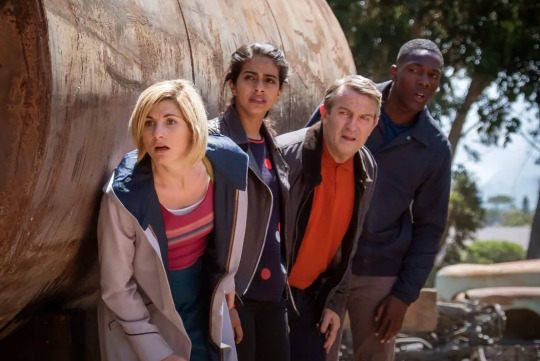
But, as the Tenth Doctor learned in his final days, he is forced into a role of protector and he ironically cannot escape that either. And so he rejects his regeneration, because he was ready to die. From his point-of-view, he had failed in restoring Bill from her Cyber conversion, he had failed to rehabilitation Missy, and all he had left now was to protect Mondasian refugees from the Cybermen. Making a final stand against an invading force was how his previous incarnation was ready to die, and I think both incarnations take some solace in knowing they will die for something noble. But here he is.... alive again and he doesn’t even know how it happened.
During “Twice In A Lifetime”, he receives comfort in learning that he hadn’t failed Bill. He is able to pull back and see how he is remembered both positively and negatively, and can see how far he’s come since his first incarnation. Then to find out that the Testimony Foundation is not just another villain to fight, but a reflection of humanity’s legacy inspires him. Mirroring that sentiment is the Christmas Armistice in World War 1 he witnesses first-hand (again) that instills a sense that, even during a brutal war, miraculous and unexpected events can still happen. He is moved, and I think it’s an excellent way to end his tenure.
Now on to the Thirteenth Doctor, and first off the general tone of the show. Yes, it has definitely changed. From the start, the new opening sequence is far more reflective of 60′s Doctor Who with its howlaround, video feedback, look. The incidental music is ambient and dark, and even the lighting seems a bit more unnerving. But this is sharply contrasted with Whitaker’s take on the Doctor, who loves her companions and is infectiously excitable. This sort of contrast reminds me very much of the Second Doctor’s tenure.
However UNLIKE the Second Doctor, the Thirteenth Doctor is far more techy and enjoys tinkering with gadgets not unlike the Third Doctor. Her big toothy grin evokes the Fourth Doctor. It’s fairly obvious that Whitaker did her homework. The stories were a little hit and miss though, but again this is nothing new. The story “Rosa” had a great sentiment, but I felt it got a little confused in its execution. This would probably have worked far better as just a historical or, like “Vincent And The Doctor”, with the alien influence really minimized. As an example where that is done successfully, “Demons Of The Punjab” really nails the tone and the writing, and stands out as a highlight for not only that series but Thirteen’s entire tenure.
To try to have Thirteen stand on her own, references in that first season to past seasons was super light and I even started questioning if Thirteen even remembered her past selves. She did, as it transpired, but the production team was pretty smart about allowing new viewers to not get bogged down with the past. Further series not only brought back references to past series, but also expanded it and shook it up pretty explicitly - but more on that next time.
And I know they really wanted to start her first episode off with a bang, but having her fall from sub-orbit and crash through a train roof was... a little excessive. It IS easily explained that the excess regeneration energy undoubtedly just healed her, but we weren’t even given that. Again I wonder what new viewers were thinking.
If I had one complaint, it would honestly be that sometimes I legitimately have a hard time following what everyone is saying. There’s something about the writing and direction, and this is not the fault of a single writer or director but probably Chris Chibnall as showrunner, that important dialogue seems to blast through really quickly and really subtly, and there were many occasions that I completely missed plot points and had to doublecheck the Wiki entry later. Whitaker does have a pretty pronounced North accent, and the other characters can rattle off their lines just as quickly as she can at times. I’m sure native UK residents don’t have this problem though.... right?
And Another Thing...
I love that David Bradley gives us a fantastic portrayal of the First Doctor, but go back and watch William Hartnell’s actual episodes: he’s not nearly as sexist or difficult as depicted in “Twice In A Lifetime”.
Yasmin: “Hey! Hold on there please, madam. I need you to do as I say. This could be a potential crime scene.” The Thirteenth Doctor: “Why are you calling me madam?” Yasmin: “Because you're a woman.” The Thirteenth Doctor: “Am I? Does it suit me?” Yasmin: “What?” The Thirteenth Doctor: “Oh yeah, I remember. Sorry, half an hour ago I was a white-haired Scotsman. When's the next train due?”
#doctor who#Twelfth Doctor#thirteenth doctor#world enough and time#the doctor falls#twice in a lifetime#the woman who fell to earth#peter capaldi#david bradley#jodie whitaker#first doctor#cybermen#TARDIS#Regeneration#review
4 notes
·
View notes
Text
Doctor Who Regeneration Series Revisited: The Twelfth Regeneration
youtube
The Eleventh Doctor: “It all just disappears, doesn't it? Everything you are, gone in a moment, like breath on a mirror. Any moment now, he's a-coming.” Clara: “Who's coming?” The Eleventh Doctor: “The Doctor.” Clara: “But you, you are the Doctor.” The Eleventh Doctor: “Yep, and I always will be. But times change, and so must I. Amelia?” Clara: “Who's Amelia?” The Eleventh Doctor: “The first face this face saw. We all change, when you think about it. We're all different people all through our lives. And that's okay, that's good, you've got to keep moving, so long as you remember all the people that you used to be. I will not forget one line of this. Not one day. I swear. I will always remember when the Doctor was me.”
Story (from “The Time Of The Doctor” and “Deep Breath”):
After being haunted by the knowledge that both his and the TARDIS’ grave is on the planet Trenzalore, the Eleventh Doctor continues to avoid his fate and delay his demise by focusing on his goal of finding Gallifrey, which he successfully hid away in a pocket universe.
Little did the Doctor realize that both his fate and his goal would intersect when he is called to assist The Church of the Papal Mainframe to investigate a mysterious signal around a planet called Christmas that has drawn species from across the universe in a strange standoff.
The Doctor, Handles (a Cyberman head), and Clara discover a human settlement on the planet, and in the clocktower is the crack in space-time that has been dogging the Doctor ever since his regeneration. Behind the crack the Time Lords are sending a message asking the Doctor to help them escape back into the universe. By uttering his real name, they will know it is safe to re-emerge. Unfortunately the signal has drawn in all the forces who wish to keep the Time Lords at bay, including the Daleks. The Doctor cannot allow the Time Lords to return as their enemies would destroy the planet as soon as they begin to emerge, and he discovers that Christmas and Trenzalore are the same planet.
Resigning himself to stay and become the protector of Christmas, the Doctor tricks Clara into returning to Earth in the TARDIS. The TARDIS begins to leave her behind, but she latches onto the exterior as it dematerializes. Because the TARDIS must protect her from the time vortex, it miscalculates its return to the Doctor, allowing 300 years to pass. The Doctor is now aged, and the towns folk rely on him as a protector. During this time, The Church of the Papal Mainframe have renamed themselves as The Church of the Silence, and a splinter group travelled back in time to stop the Doctor from ever reaching this point, dogging him this entire regeneration (see: River Song especially). and even creating the cracks in space-time by destroying the TARDIS in an aborted timeline. Paradoxes are fun.
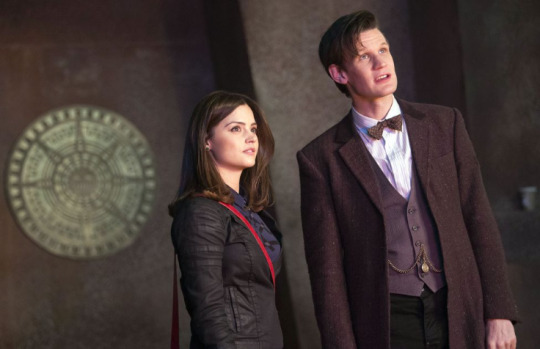
The Daleks are closing in, and the Doctor tricks Clara into being sent back to Earth again. But this time Tasha Lem arrives in the TARDIS to retrieve Clara to be with the Doctor on his death bed, as even more centuries have passed. The Doctor is now ancient and the Daleks are the remaining force. The Doctor is resigned to his death and goes to face off against the Dalek fleet one last time. Clara goes to the crack in the clocktower wall and pleads with the Time Lords to change the Doctor’s future by saving him. The crack closes, then reopens above the Doctor, granting him more regenerations before closing permanently.
The Doctor is imbued with an excess of regeneration energy, using it as a weapon to annihilate the Dalek fleet. Upon their destruction, he returns to the TARDIS. Before Clara follows him, he makes a phone call to Clara several days in her future, asking her to help the new incarnation of the Doctor and assuring her that everything will work out. His body resets to a younger version of his current incarnation, and Clara arrives in the TARDIS. He hallucinates Amy Pond, bids her farewell, then bids Clara farewell before suddenly regenerating.
The regeneration energy fries the console, and the TARDIS plummets through several eras before being swallowed by a tyrannosaurus. The tyrannosaurus then materializes in Victorian London, and coughs up the TARDIS. The Doctor, in the midst of a regenerative fugue, collapses in confusion by his friends the Paternoster Gang, who take him and Clara to their base of operations. That night, the lonely and frightened tyrannosaurus is murdered and burned. While Clara is distraught over the regeneration, the Doctor escapes to investigate the burning of the dinosaur and try to determine who he is and what kind of a man he will be.
Production:
After four years, and an infuriating release schedule that would only get worse as the seasons went on, Matt Smith announced he was leaving the role of the Doctor with the Christmas special in 2013 being his last appearance. The Christmas specials had been a frequent tradition that were used to bridge the gap (and keep fans invested) between seasons. Sometimes they had little to do with the seasons, but as with the very first Christmas special (and no I’m not counting “The Feast Of Steven” from the First Doctor), this Christmas special was required viewing. Showrunner Steven Moffat promised to tie up his loose ends that had been kept dangling since the beginning of Matt Smith’s tenure.
As Matt Smith was also active in other projects at the time and needed a buzzcut in particular, a wig was needed for his scenes to keep continuity. However during one stunt, Smith injured his leg and required a cane to hobble around. Instead of trying to write around this (leaning against walls all the time?), Moffat decided to smartly incorporate it as part of the Doctor’s continued aging while stranded on Trenzalore. This was a phenomenal choice, as not only did it harken back to the First Doctor, but Smith is a very physical actor so giving him something to gesticulate with worked out well.
Casting for the new Doctor sound landed on Peter Capaldi, who was an obvious choice. There was no surprise by the time Christmas rolled around that he would be the new face, as the audience had the briefest of cameos by him in the special “The Time Of The Doctor”, as the next regeneration. And Capaldi had been tied to the series for years: he had been invited to audition for the part of the Eighth Doctor back in 1995, and he had played two roles in the franchise already as Lobus Caecilius opposite the Tenth Doctor in “The Fires Of Pompeii” and as John Frobisher in Torchwood’s third (and arguably only good) season “Children Of Earth.”
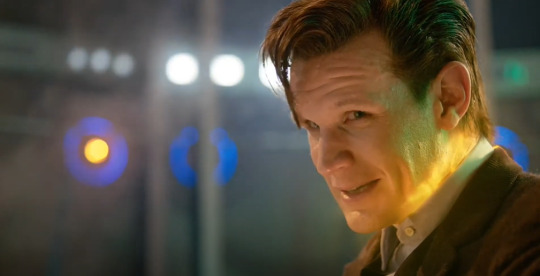
Perhaps the biggest lingering plot thread was how the Doctor would regenerate and how many he had left. The Tenth Doctor’s aborted regeneration was a point of contention (did it count??) and as stated in the previous article the Eleventh Doctor had been giving glib answers about his remaining regenerations during the last few years, most noteworthy being during “The Sarah-Jane Adventures”. Well Moffat answered both those questions unexpectedly. First was that this WAS the Doctor’s final form, as both the War Doctor and the aborted regeneration did indeed count. And second was that the Time Lords were to grant the Doctor further regenerations. This was honestly a fairly good solution, as the Time Lords had granted the Master more regenerations in the past so it was already a concept that fans were banking on.
Moffat also managed to tie in the crack in space-time and the conspiracy of the Silence, and there would be very little need to carry over these storylines into the Twelfth Doctor’s run. The story of the Time War had been an ongoing thread for the previous eight years (for better or for worse) and Moffat felt it was time to move on.
For the regeneration, there was a conscious decision to not drag out the effect this time, and a simple swap out in-camera trick with a flash of special effects was all that was needed. This allowed the TARDIS set to be unaffected by the frequently destructive energies of the regeneration, but also to keep the ending moving at a frantic pace, roping in audiences for the next season.
Analysis:
Sometimes I think these plot synopses I gave just keep getting longer and longer. In fairness, Moffat really slammed a lot into that last story, and it was three seasons in the making. Or maybe more accurately seven seasons and a bunch of miscellaneous specials in the making, seeing as this seems to really cap the Time War story. There will be Gallifrey-centric stories to come, but the Time War isn’t as much a factor anymore. And I will absolutely commend Moffat here: the story doesn’t slog on or feel too ambitious for what it executes. Besides a couple scenes with Clara’s family (gotta shoehorn in that Christmas theme), it feels appropriately like this could be the end of the Doctor’s long life. And he has arguably lived in this incarnation the longest. I think he even has the First Doctor and War Doctor beat. After all, this incarnation is over 200 by the time of “The Wedding Of River Song”, then he hits over 500 midway through this episode, then who knows how many more centuries go by to get to his elderly state. Impressive.
And it also casts some of this Doctor’s past behaviour in a new light. When the Doctor, Amy, and Rory land on Apalapucia in “The Girl Who Waited”, the Doctor refuses to leave the TARDIS as the Chen 7 virus has run rampant and will kill any being with two hearts. He claims that it would prevent him from regenerating, but now we know he had no regenerations left! So under normal circumstances, maybe he would regenerate (as he did with Spectrox Toxaemia in “The Caves Of Androzani”).
Okay let’s chat about Steven Moffat for a minute here. When it was announced that he was replacing Russell T. Davies as showrunner, people were legitimately stoked, as was I. And that’s because you could make a strong argument that all the episodes he had penned in the RTD era were the best of the series. Who doesn’t love “The Girl In The Fireplace” or “Blink”? So it seemed only natural that the direction the show would go would only be positive.
Man, haters gonna hate. It didn’t take long before the whining started about how awful the stories Moffat was putting out were. How nothing could compare to the RTD era (conveniently forgetting the stinkers RTD wrote, like “Love & Monsters”). And looking back, yeah some plots were a little TOO grandiose and ambitious, and it did get a little tiring that every season had to end on narrowly averting the greatest catastrophe that threatens all of existence. Even though that was a carryover from the RTD era. But with hindsight I think the fans have really come around to appreciate the Moffat era and Smith’s run. By the time of the 50th anniversary special “The Time Of The Doctor”, Smith was very popular because of how well he understood the role.
I think part of the issue was the tone change. SFDebris really said it well when he noted that RTD would take you to different planets, but Moffat would take you to different worlds. It’s hard to put your finger on at times, but there’s something a little more fantastical about Smith’s run. Plus the later dynamics of having a married couple aboard the TARDIS, and then a woman who was a continual temporal reincarnation led to some truly brilliant outings (especially “Amy’s Choice” and “Journey To The Centre Of The TARDIS” respectively).
Anyway I have then and still do stand behind Moffat’s run, and man was I thrilled with how the series was going. Keep it fresh! Keep it moving!
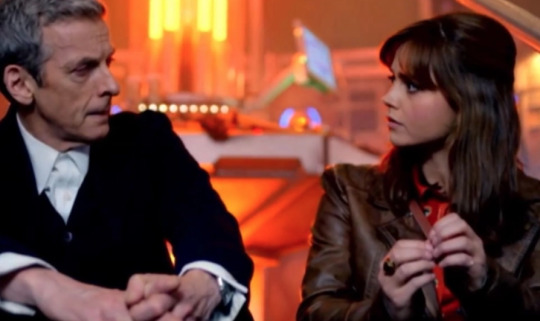
There were a couple issues I had with “The Time Of The Doctor” however. The first is wrapping up the whole Silence story arc. If you left the living room to hit the bathroom, you’d miss completely the origin of the Silence and their vendetta against the Doctor. I appreciate that the origin was accounted for and think it was fairly clever, but I think we could have excised some of the Clara family scenes to really revel in the gravity of that development. And yeah I totally understand that they were trying to ground the story in typical Earth family life, and maybe draw some parallels between a spirit of thanksgiving and family with the overall story, but it kinda slowed down the story for me.
But I think my biggest qualm might be the Doctor using his regeneration energy to annihilate the Dalek fleet. So the lead up with the Daleks being the last of the invading forces to stick around was okay for me, it makes sense. And we know regeneration energy can occasionally be destructive, although I thought originally that was tied to the amount of radiation the Doctor absorbed in “The End Of Time”, but okay. And I’m also going to accept that the Daleks wouldn’t just turn tail and run, especially with the reappearance of the Time Lords on the line. So there’s our setup: we have a dying Doctor being given a new cycle of regenerations, and a Dalek fleet ready to descend on him and destroy the town of Christmas. How do you resolve this?
One thought I had was that maybe the town could come out and make a last stand with the Doctor. That they would have gathered weapons to repel the Daleks. Or perhaps the Time Lords erect a force field of some kind around the town while this is happening. But let’s use our brains here and not resort to the Doctor committing a tremendous act of violence while he’s dancing on a rooftop.
There was a lot speculation about why the Doctor “chose” this incarnation, and certainly there were rumours flying around that Capaldi’s previous two roles in the franchise would be linked to the regeneration. This wound up not being quite true, as the Doctor acknowledges he looks like Caecilius as an affirmation of what kind of character he should possess. So okay. The writers could have chosen to just ignore it and move on, but okay. I personally believe that the Doctor was influenced by.... himself. When he called Clara pre-regeneration, he heard his future self speaking and deduced that he’d be old and grey. Maybe thinking about what you look like will influence how you regenerate? Would explain why the Sixth Doctor looks like Maxil and how Romana could look like Princess Astra
Ultimately though I think this story holds up pretty well. The Doctor has been haunted by his faith, haunted by his crimes, and haunted by the loss of his closest companions (esp. Donna, Amy, and Rory). In his last years he began to find redemption and absolution, then acceptance in his role as a guardian of a people under siege. And then finally vindication. This truly is the Time Lord Victorious.
And Another Thing...
That whole holographic naked gag was really far too silly.
The Twelfth Doctor: “Why this one? Why did I choose this face? It's like I'm trying to tell myself something. Like I'm trying to make a point. But what is so important that I can't just tell myself what I'm thinking?” Barney: “Err...” The Twelfth Doctor: “I'm not just being rhetorical here. You can join in.” Barney: “I don't like it.” The Twelfth Doctor: “What?” Barney: “Your face”. The Twelfth Doctor: “Well, I don't like it either. Well, it's all right up until the eyebrows. Then it just goes haywire. Look at the eyebrows. These are attack eyebrows. You could take bottle tops off with these.” Barney: “They are mighty eyebrows indeed, sir.” The Twelfth Doctor: “They're cross. They're crosser than the rest of my face. They're independently cross. They probably want to secede from the rest of my face and set up their own independent state of eyebrows. That's Scot. I am Scottish. I've gone Scottish?”
#doctor who#Matt Smith#peter capaldi#TARDIS#The Time Of The Doctor#Deep Breath#Eleventh Doctor#Twelfth Doctor#review#regeneration
2 notes
·
View notes
Text
Doctor Who Regeneration Series Revisited: The Eleventh Regeneration
youtube
Wilfred: “Still with us?” The Tenth Doctor: “System’s dead. I absorbed it all. Whole thing’s kaput. Oh! Now it opens…yeah.” Wilfred: “Well, there we are then! Safe and sound. Mind you, you’re in a hell of a state. You’ve got some battle scars there. But they’ve…your face! How did you do that??” The Tenth Doctor: “It’s started.”
Story (from “The End of Time (Parts 1 and 2)” and “The Eleventh Hour”):
After hearing the prophesy that his life will end after hearing a man knock four times the Doctor goes on numerous trips through time and space to avoid his fate. Finally Ood Sigma contacts the Doctor and convinces him to come to the Ood Sphere. Once there Ood Sigma informs the Doctor of not only the Master’s reincarnation but a dark force threatening to wipe out all of existence (again).
The Doctor arrives at Earth in the present day to find that billionaire Joshua Naismith has acquired a devise called the Immortality Gate and plans on using it to grant his daughter immortality. However he can not get it to work and has kidnapped the Master to fix it. The Master’s reincarnation was incomplete, however, and he has become unstable, brimming with strange telekinetic powers and requiring a constant supply of meat (even live humans).
The Master sabotages the Gate before the Doctor can stop him and changes the function of it to overwrite ever human’s DNA and mind with that of the Master’s, except Donna Noble due to her subdued but still imbued half Time-Lord nature (see “Journey’s End”) and her grandfather Wilfred (who the Doctor has protected).
However the true nature of the Gate soon becomes apparent. In the last day of the Time War the Lord President Rassilon (more on this later) and the High Council, save two, voted on sending the whole of Gallifrey into another time and place, away from where the War Doctor was about to use The Moment. To achieve this they had sent a signal through the time vortex into the mind of the Master when he was a child and staring into The Untempered Schism (see “The Sound of Drums”). It was this signal that drove him mad. And now that the Master is using a Whitepoint Star Diamond with the Immortality Gate, the Time Lords can escape the Time War.
At first the Master tries to take advantage of this opportunity by using the Gate to overwrite the Time Lords biology as he did with the Humans but Rassilon easily thwarts this attempt. The Doctor warns the Master that the Time Lords have to be sent back and reveals that during the Time War the Time Lords became insane with the evils they had committed. Indeed, now free of the war, they intend to evolve themselves to a higher plane of existence at the cost of the universe itself.
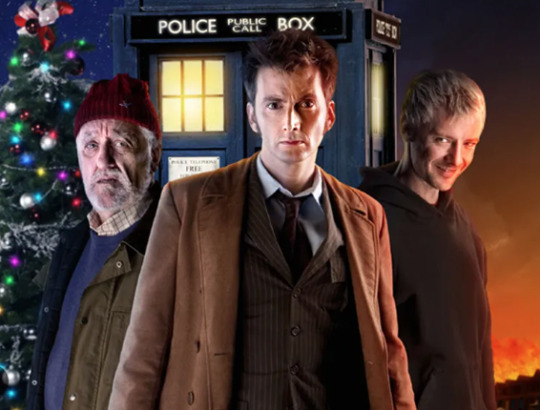
As the war-torn Gallifrey begins to appear in Earth’s orbit the Doctor, with Wilfred’s gun, finds himself having to choose between severing one of the two points keeping the link open: the Master or Rassilon. He hesitates between shooting either until he sees one of the dissenting High Council is a woman he recognizes. She nods to him and the Doctor is inspired. He turns and shoots the Whitepoint Star Diamond, destroying the focus of the link. The Time Lords start being sent back into the Time War and Rassilon prepares to kill the Doctor with his gauntlet before he vanishes. The Master, infuriated that his whole tormented life was orchestrated by the Time Lords’ plan, rushes at Rassilon and the two fall into the Gate and back into the War to be killed.
The Doctor, astonished that he is still alive, suddenly hears four knocks from Wilfred, who is in a chamber sealed for the Immortality Gate’s radiation purge. The only way out is for someone to go into the adjacent chamber and release the door mechanism. Wilfred pleads with the Doctor to not bother saving him, as he is an old man who has already lived his life. The Doctor is anguished at first with being confronted by this scenario but knows he can not sacrifice Wilfred’s life for his own. He goes into the second chamber and releases Wilfred just as the radiation purges and seeps into his body.
With the radiation released the chamber door opens and Wilfred perceives the Doctor as being all right. The Doctor reveals that he is dying due to radiation poisoning then leaves. While dying the Doctor visits all his past companions to see how they are faring (but we only see a select few) even pausing to wish Rose Tyler a happy New Year in January 2005.
Staggering into the TARDIS the Doctor engages in flight before tearfully admitting he doesn’t want to go. The regeneration commences explosively, shooting radiation and heat out of his body, and devastates the TARDIS console room. The regeneration complete, the Doctor inspects himself cheerfully to see how he looks and then remembers the ship is plummeting towards the Earth.
Crashing in a backyard pool in 1996, the Doctor climbs out of the dilapidated TARDIS and meets 10 year old Amelia Pond. The Doctor demands to be fed and Amelia tries to feed him an assortment of food, which the Doctor in his confused state believes to all be poisonous. He soon discovers that Amelia is haunted by a crack in her wall which is a crack in space-time leading to an Atraxi prison. And coming from that crack is a message that “Prisoner Zero has escaped.”
Production:
After three full years David Tennant and the production team had taken the already successful Doctor Who and built upon it. Ratings were consistently high, and every season head writer / executive producer Russell T Davies was shooting for bigger and better things in the program.
Under his wings plot elements from the classic series crept back in for a new audience including Davros (creator of the Daleks), the Sontarans, the Macra, and the Master. There was even an appearance of the Fifth Doctor in “Time Crash.” At this point there was no question that not only was it a continuation of the old series, but was as popular as it as well. David Tennant became as recognized in the role as Tom Baker had been thirty years before.
However Tennant decided that he had spent enough time on the series and was game to move on. Likewise the production team was ready to move on as well and Davies was ready to hand over his titles to Steven Moffat, a regular writer on the series. To ease the transition, in lieu of another season, 2009 would have five hour-long specials airing through out the course of the year: Christmas 2008, Easter, November 15th, Christmas 2009, and New Years 2010.
Steven Moffat was the most logical choice to fill the shows Davies was leaving behind. Again, he was already writing for the program, and he was also a long-time fan. Sitting down with the rest of the new production team (executive producers Piers Wenger and Beth Willis, and producer Tracie Simpson) it was a consensus that they wanted to find a older, more distinguished actor. 26 year old Matt Smith was the first person to audition and greatly impressed the team. However they continued to audition others because they were worried about passing the torch to someone so young.
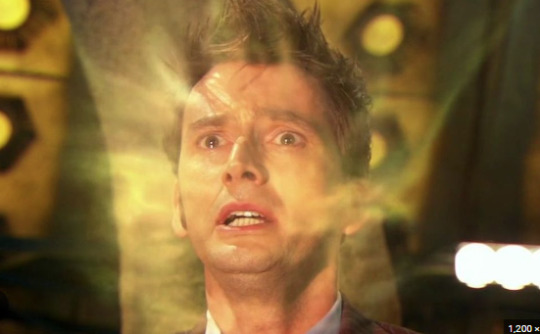
In the end the team couldn’t find anyone who matched Smith’s obvious talent and hired him on, making him officially the youngest actor to play the Doctor so far. Unlike Tennant, Smith had no real exposure to Doctor Who before. Granted, he was aware of it but he was from a generation that grew up in that gap between series. So Smith took the assignment to heart and watched some old stories to catch up.
The production team’s initial idea for the Eleventh Doctor’s costume was actually more like Captain Jack Sparrow from the Pirates of the Caribbean franchise (a chic swashbuckler?). However Smith became quite taken with the Second Doctor’s portrayal upon watching “Tomb of the Cybermen,” and insisted on a costume more reminiscent of that. He noted that the chic swashbuckler look was not how the Doctor would dress himself, and instead brought back the bowtie.
As for the regeneration itself, Davies’ team had already firmly established that unlike regenerations in the old series they wanted consistent-looking effects. As such, when the Master regenerated in the Tenth Doctor story “Utopia” it was basically the same effects but with a few different colours. So when the Doctor regenerated in this story we see essentially the same effect yet again with one notable difference: the explosion of fire outwards. This served the story well too; after this devastation they could change the TARDIS set.
Analysis:
When I wrote the original version of this article, I had serious qualms about the Doctor lamenting how much he didn’t want to go. I thought it took away from his assertion of his identity over the temptings of the Time Lord Victorious, and removed some of the heroic nature of his character. After all we had seen him stare down the biggest threat to all of creation while still finding the bravery to accept death through sacrifice. And further to that, I felt the shrieks of despair of ravenous Doctor Who fanatics who were crying their eyes out and wailing back to their television screens that they also didn’t want him to go.
But I’ve come to reevaluate this stance.
While I will admit there is definitely some fan service, and arguably some writer service, in going back and seeing all the companions and having the Doctor begin to weep at his upcoming regeneration, I don’t think it is just that. Firstly with hindsight we now know that the Doctor is now using up his last regeneration. So this is more than just regenerating - this is his final regeneration and is one step closer to death. And in that time we is still filled with regret over the Time War. Not only does he still have no way to absolve that guilt, but he had to reaffirm it by ensuring that the High Council and the Master were forced to stay behind on Gallifrey while it burned. And that the planet itself was sent back into the hellfire. That’s pretty rough!
Remember, he has no memory of the events of “The Day Of The Doctor”!
He has also had to watch as an actual half-human doppelganger is now living in an alternate universe with one of the very few women he has allowed himself to fall in love with. Actually scratch that: he didn’t just watch it, he facilitated it. His best friend, Donna, has had her mind wiped and is living as a more shallow previous version of herself.
But perhaps most telling of this mentality comes from his experience in “Human Nature” and “The Family Of Blood”. As the human John Smith (missing his Time Lord memories and nature), he fell in love with Joan Redford and intended to spend his life with her. The Doctor retains those memories and even shared a telepathic glimpse with her of what that life could have been like. For all the times the Doctor has empathized with humans, for once he actually became one and felt real mortality.
I think it’s that retreat to and acceptance of those feelings of mortality that the Doctor allowed himself to experience one last time that led to his sudden declaration of not wanting to go. Whereas when it was said during “The Day Of The Doctor” it was more of a musing, when said here it’s him stripping down and being honest with himself. And even more important to note, it is only him with the TARDIS.
As for the story itself, I like “The End of Time” quite a bit. I think it really ties things together for the Time War, at least up until that point. I originally had written that I felt Davies had tied together all the loose ends of the Time War and was looking forward to moving on to new things. Fortunately Steven Moffat was able to bring in some new angles on the War as well as introducing some excellent new material. I wound up being very happy with the Eleventh Doctor’s run.
Rassilon, played by the ever sinister Timothy Dalton, is a great addition. And yes I believe he is THE Rassilon, hero of Time Lord society, who has been dead for millennia. We saw in “The Five Doctors” that he was really not dead as much as non-corporeal. So I think it’s reasonable that the Time Lords resurrected him in this great time of need. Too bad he went bonkers.
There’s some question as to who that mystery woman from the High Council is that helps Wilfred and tips the Doctor off at the end. Davies said that it’s implicitly supposed to be the Doctor’s mother (again, totally disregarding the “half-human” theory) but could we not entertain the notion that it’s Romana? If you’re firmly in the camp that Romana never escaped E-Space (even though the audio adventures state she did and became Lord President for a while), what about Flavia? Or here’s a wild card…the Rani? The Time Lord High Counsel would not be above recruiting a sociopath like her to include in their ranks.
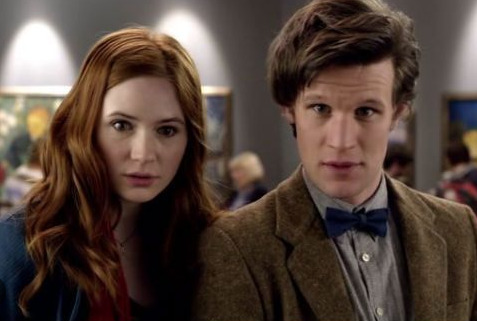
I’m quite happy with the Eleventh Doctor and Matt Smith’s portrayal. I’m a big sucker for a youthful appearance betraying the wise man underneath – hence why I really dug the Fifth Doctor. That doesn’t mean I want only young men to play the role but handled correctly I think it makes for a fascinating character to watch. And Smith nailed the costume on the head; the look is excellent.
“The Eleventh Hour” was also a great introductory episode. It was very accessible which is something I really expect from a first episode even for a season. There’s no real need to see any Doctor Who previously.
The Doctor post-regeneration is a little less catatonic and a little battier. He’s first worried that he’s swapped genders and then he’s dismayed to learn that he’s still not a redhead (something the Tenth Doctor was hoping to be, mentioned in “The Christmas Invasion”). He has a strange curiousity about every new experience but the knowledge is still there in his head and it slowly reasserts itself through the episode. The adult Amy Pond, played by Karen Gillan, is a great choice as well. This is a quirky girl who’s tormented – not an easy role to fill.
I have always enjoyed Steven Moffat’s stories in the past seasons so imagine my elation to hear that he was becoming head writer. I was ecstatic. I remember a lot of fans were likewise thrilled, but Moffat’s tenure quickly became a divisive one. Truthfully I don’t see what the big issue was. RTD was a great writer but released some stinker scripts, and Moffat was the same. But Moffat was focused more on the fantastical stories and I think that tone shift rubbed some fans the wrong way.
The new title sequence and the new TARDIS set were also welcome additions to the production. If the production team was looking for a way to kick-start the series and bring in fresh blood, they definitely found it.
I want to quickly mention The Sarah-Jane Adventures episode “Death of the Doctor.” For those who don’t know, back in 1981 a Doctor Who spinoff series called “K-9 and Company” spawned a pilot episode. The series would revolve around ex-companions Sarah-Jane Smith and the robot dog K-9. It was not produced further than the pilot allegedly because the then-BBC1 controller really hated it (I saw it recently and it IS a little silly). Anyway in 2007 the Davies Doctor Who team produced a new version of the show called “The Sarah-Jane Adventures” which again starred Sarah-Jane but had less K-9 and instead a supercomputer named Mr. Smith, and a kid named Luke who’s some genetic copy of someone or something. Anyway there was a few Doctor Who crossovers and the “Death of the Doctor” includes the Eleventh Doctor. While talking to this kid Clyde the Doctor says he can regenerate 507 times. Naturally fans were aghast. How does THAT make sense? Time Lords can only regenerate 12 times! Davies (probably) sighed really loudly and then issued a statement saying the Doctor was just being glib, and that he had no intent on taking something so integral to the series and tossing it out in an odd line on another series entirely. This wound up being held true, but I figured I’d mention it anyway since it’s related.
And Another Thing…
The Sarah-Jane Adventures would be far better if they got rid of the teens.
The Eleventh Doctor: “Legs! I’ve still got legs! Good. Arms! Hands! Ooh, fingers! Lots of fingers! Ears! Yes, eyes, two. Nose. Ooh, I’ve had worse. Chin! Blimey! Hair! I’m a girl! No! No…I’m not a girl! Oh…and still not ginger!!”
3 notes
·
View notes
Text
Doctor Who Regeneration Series Revisited: The Tenth Regeneration
youtube
Rose: “You’re not making sense.” The Ninth Doctor: “I might never make sense again. I might have two heads, or no head. Imagine me with no head – and don’t say that’s an improvement. It’s a bit dodgy, this process. You never know what you’ll end up with." Rose: “Doctor!” The Ninth Doctor: “Stay away!” Rose: “Doctor, tell me what’s going on.” The Ninth Doctor: “I absorbed all the energy of the time vortex and no one’s meant to do that. Every cell in my body’s dying.” Rose: “Can’t you do something?” The Ninth Doctor: “Yeah, I’m doing it now. Time Lords have this little trick; sort of a way of cheating death.”
Story (from “Bad Wolf”, “The Parting of the Ways”, the 2005 Children In Need special, and “The Christmas Invasion”):
The Doctor, Rose, and Captain Jack are kidnapped from the TARDIS and forced to play reality game shows in the far future, where the penalty for losing is death. The Doctor breaks out and discovers that the whole network of game shows are situated in a space station, and that the network controller kidnapped him in the hopes of using him to defeat her masters, who are revealed to be the Daleks.
The Doctor is astounded that the Daleks survived the Time War, and the Emperor Dalek reveals himself. His ship was the lone survivor of a cataclysmic event (The Moment, as stated in the last entry), and fell through time to the outer reaches of Earth’s solar system. Over several hundred years the Emperor harvested humans to slowly rebuild his Dalek army and was driven mad by his isolation, deluding himself to believe he was a god.
The Daleks now intend to invade Earth, totally complacent in its mindless entertainment, and from there build the empire up to conquer the galaxy. The Doctor realizes the only way he can stop them is to build a Delta wave emitter using the transmitter of the station, but there’s not enough time to refine it. As such any Delta wave emitted would not just kill the Daleks but the population of the Earth as well.
The Doctor tricks Rose into staying in the TARDIS, and he remotely sends it back to her own time, locking the controls. Rose is furious and while back in her own time sees the words “Bad Wolf” all around her, which she had seen all through her adventures with the Doctor as if the words were following her through time. She realizes that it is a message and breaks into the TARDIS’ telepathic circuits. The TARDIS console opens and floods her mind with the energy of the time vortex.

The Daleks confront the Doctor and he admits that he can not bring himself to commit genocide (again). Just as the Daleks approach to exterminate him, the TARDIS arrives. Rose steps out, teeming with the energy of the time vortex, now omnipotent. She annihilates the Dalek fleet with a wave of her hand and resurrects Captain Jack, who had been killed earlier. But the Doctor pleads with her that not only is it wrong for her to stay like this but the energies will destroy her. She can not give up the power she now has, so the Doctor kisses her and absorbs all the energy into himself, before quickly breathing it back into the TARDIS.
After setting off into flight Rose awakens with amnesia of the events and the Doctor warns her of his impending regeneration due to the burn out caused by the energies. After a paranoid rambling he regenerates and immediately notices new teeth. Inspecting himself he notices all the changes in the regeneration and wants Rose’s opinion.
She denies that he could be the Doctor, instead suspecting a plot of some kind. He tries to convince her he’s the same man but she’s still suspicious. He asks her if she wants to leave and she’s undecided. The Doctor sets the TARDIS controls back to her home at Christmas time but then succumbs to the effects of post-regeneration trauma, lapsing into a manic craze.
The TARDIS crashes onto the street and the Doctor wishes Rose’s mom Jackie and Mickey a Merry Christmas before collapsing into a coma. While recuperating the Doctor becomes a target for robots dressed in Santa costumes. Meanwhile the invading force of the Sycorax has arrived, and Rose finds she may be Earth’s only hope.
Production:
As stated in the seventh regeneration article the viewing figures for the 1996 Doctor Who tv movie were very high in the UK. While the audio dramas and novels were in full swing it was also apparent the audience for the program never really left. Producer Mel Young approached the then-current BBC One Controller Peter Salmon about relaunching the series and through them writer and Doctor Who enthusiast Russell T Davies was brought on board for contributions. However this fell through and Davies went on to work on a little unknown series called “Queer as Folk”.
By 2003 Davies had attracted enough attention as a writer to be brought back to the new Doctor Who project. By this point the new BBC One Controller Lorraine Heggessey had completely cleared up any rights issues – as remember with the television movie, Universal, Fox, and BBC Worldwide had all been on the production. But by now BBC television had the authority to pursue a series with no difficulty, opting to produce it with BBC Wales and the Canadian Broadcasting Corporation (the CBC).
Davies was to be not only the head writer but the executive producer as well. Also producing were Phil Collinson and BBC Wales Head of Drama Julie Gardner. Those principal three would be the main creative driving force behind the new series. Casting calls were held for who would play the Doctor and the team settled with Christopher Eccleston, a man who had never been a fan of the series in the past. In fact Eccleston would criticize the old series for its “wobbly sets”, although admitted he found the concept of regeneration fascinating.
No one was sure if the series would even take off, so they settled on making one season before committing any further. However when ratings pulled in 10.5 million viewers for the first episode “Rose” a second season was commissioned, and everyone signed up.
Except Chris Eccleston. He wasn’t too keen on the atmosphere of the set and had fears of being typecast, so he wished to go after the first season. It was originally intended to be a surprise to the audience, since they were announced for another season, but the BBC accidentally released this information early against Eccleston’s contract. Everyone was a little incensed and to this day Eccleston isn’t happy with how the BBC handled his departure. Nevertheless Eccleston still to this day is proud of his time in the role and adores the fans of the series.

Casted to replace him was 30 year old Doctor Who fan David Tennant. Tennant had already done roles in many of the radio dramas and was thrilled at the opportunity to play his childhood hero.
You may have noticed the citing of many episodes for the story. That’s because even though the new series format was to have standalone episodes, unlike the multi-episode story arcs of the past, Davies enjoys having plot points work their way through an entire season. In this case Davies had written in references to the “Bad Wolf” in almost every episode, some of which barely noticeable. The Children In Need special listed above was a seven minute charity piece that was a short dialogue scene as the Doctor feels his new body out before going manic.
As for the regeneration scene, a straight video morph effect with lights and energy were used. Relatively simple but flashy enough to inspire those who had never seen a regeneration before. And by setting it up with dialogue beforehand, the hope was that audiences wouldn’t feel alienated.
Analysis:
First off, I love Eccleston’s portrayal of the Doctor. He’s a quirky guy totally unlike anyone else he’s every played in the past. But he also shows a pain and a rage beneath that humour. And as much as I loved Tennant’s performance I really do wish Eccleston would have hung around for one more season.
Nevertheless I was still pretty psyched at seeing a new regeneration. After the effects of the last series, which were inconsistent, I was eager to see how much better this one would be. The budget was significantly better and we as an audience were far more emotionally invested in the event.
Okay so in regards to this “Bad Wolf” entity Rose becomes, it’s an interesting plot device and it would have seemed like a cop-out, if not for the how we’ve been seeing its effects through almost the whole season. So I’m okay with it. One might be wondering why Rose didn’t die from absorbing it while the Doctor did. To this I say that it makes sense that while the Doctor was imbued with its energies he reversed any damage to Rose before putting the energy back into the heart of the TARDIS. One wonders about those continents the Daleks fried before they were stopped. Rose brought Captain Jack back, what about all those people? Who knows.
Back to the heart of the TARDIS, this was a concept that has been around a long time. The first reference goes back to the First Doctor in a 1964 story arc that has been retroactively titled “The Edge of Destruction.” The TARDIS is being plunged back to Event One and will be destroyed. However the Doctor and his companions don’t realize this so the TARDIS tries to warn them. From that point on in the series it is explicitly understood that the TARDIS has a degree of sentience.
We even saw the TARDIS use these energies to revive Grace and Chang Lee in the TV movie, based on sentimentality. And then in “Boom Town” when Blaine is trying to commandeer the TARDIS by holding Rose hostage she is exposed to the heart which rejuvenates her until she is an egg, giving her a second chance at life. So undoubtedly when Rose and the TARDIS communicated, it gave her the power it needed to resolve the situation because of compassion for the Doctor.
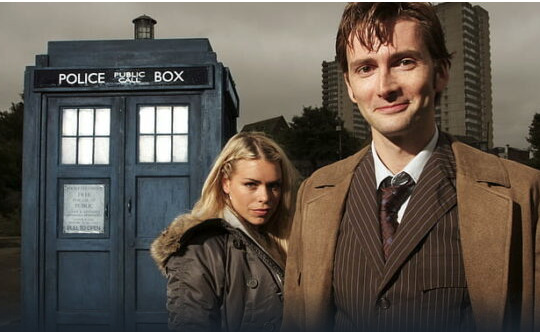
For most of the Tenth Doctor’s first story “The Christmas Invasion,” the Doctor is near comatose, expressing the regeneration had gone wrong. So no Zero Room this time? I’m actually of the opinion that it’s another example of the post-regeneration trauma manifesting itself as paranoia. I honestly enjoyed how it was the smell of herbal tea that healed his stressed synapses and allowed him to recover. I also enjoyed the scene in which the Sycorax suddenly seem to be speaking English as soon as it’s apparent the Doctor has recuperated. From that point on Tennant owns the episode, silencing those who doubted if he had the character to pull off the role.
No too much to say on this one, other than I really enjoyed Doctor Who coming back and the regeneration was very well done. And with David Tennant taking over the reins, the series would see even greater ratings and an entirely new audience.
And Another Thing...
I really wish they’d go somewhere else besides Earth. They’ve got the whole universe to explore!
The Tenth Doctor: “Now then, what do I look like? No no no no no no no no no – don’t tell me. Let’s see. Two legs, two arms, two hands, slight weakness in the dorsal tendon. Hair! I’m not bald! Ooooh, big hair. Sideburns, I’ve got sideburns! Or really bad skin. Little bit thinner, that’s weird, give me time and I’ll get used to it. I have got a mole. I can feel it. Between the shoulder blades is a mole. That’s all right. Love the mole. Go ahead, tell me, what do you think?” Rose: “Who are you?” The Tenth Doctor: “I’m the Doctor!”
#doctor who#christopher eccleston#david tennant#Regeneration#review#TARDIS#the christmas invasion#the parting of the ways#bad wolf
6 notes
·
View notes
Text
Doctor Who Regeneration Series Revisited: The Ninth Regeneration
youtube
The Old Warrior: “Well, gentlemen, it has been an honour and a privilege.” The Tenth Doctor: “Likewise.” The Eleventh Doctor: “Doctor.” The Old Warrior: “And if I grow to be half the man that you are, Clara Oswald, I shall be happy indeed.” Clara: “That's right. Aim high.” The Old Warrior: “I won't remember this, will I?” The Eleventh Doctor: “The time streams are out of sync. You can't retain it, no.” The Old Warrior: “So I won't remember that I tried to save Gallifrey rather than burn it. I'll have to live with that. But for now, for this moment, I am the Doctor again. Thank you.”
Story (from “The Day Of The Doctor” and “Rose”):
After countless years of the Time War between the Time Lords and the Daleks, with weapons of mass destruction on a temporal and galactic scale, the Old Warrior once known as the Doctor has finally seen enough. War crimes of horrific proportion have been committed by both sides. Weapons and tactics used included the Skaro Degradations, the Horde of Travesties, the Nightmare Child (and, apparently, its jaws), and my personal favourite the Could-Have-Been King with his army of Meanwhiles and Neverweres. The Time Lords resurrected the Master to use as a fighter, only to have him desert them when the Cruciform fell.
And at the end of it all, during the last great push by the Dalek to annihilate Gallifrey, the Old Warrior could say just one thing: NO MORE. Taking the the streets, a hero to many, the Warrior picked up a gun and blasted that message into a stone wall. Then he left and broke into the Omega Arsenal in the Time Vaults - the holding place for their most dangerous weapons.
There in the nearly empty collection was the most dangerous of them all: The Moment. Also known as the Galaxy Eater, it had been developed by the Ancients of Gallifrey in their final days. The Moment had become so powerful in its manipulations and control over time that it had achieved sentience. Not only could it end the war in an instant, but it could try to talk you out of it.
Bundling up The Moment in a burlap sack, the Warrior piloted his TARDIS out to the desert wastelands of Gallifrey, before walking the rest of the way to a barnyard from his childhood. He placed the weapon on a stand and began to look for how to activate it...
Story (Original Timeline):
The future was in flux. There were countless scenarios that could arise that would kill the Doctor or otherwise impede his travels through time and space. With so much of time in question, and so much of the future resting on this decision, The Moment did not hesitate in granting his interface. The weapon was activated, and the Doctor scarcely had time to leave before Gallifrey and the whole of the Dalek race were obliterated.
With the stress of what he had just done overwhelming him, the Old Warrior regenerated into the Ninth Doctor. Alone, he felt a terrible burden of responsibility to mitigate and heal some of the damage that he was a party to. We can’t say for sure that it was during this brief period that he sailed on the Titanic, witnessed the JFK assassination, and found himself stranded on a beach after the eruption of Krakatoa, but certainly they were presented as during that period by Clive to Rose (in “Rose”). That being said, there’s nothing explicitly saying that they weren’t from later in his travels with Rose.
It wasn’t much longer that the Doctor became wise to the reappearance of the Nestene consciousness on Earth, following the destruction of their homeworld in the Time War. Again, as the Doctor felt partly responsible for the situation, he began an investigation that would hopefully end with the Nestene leaving peacefully. And also hopefully not resurrecting an army of plastic mannequins to conquer the world...

Story (New Timeline):
After hundreds of years, and several regenerations, worth of adventures, the Eleventh Doctor is called to (well...dragged to) the National Gallery by Kate Lethbridge-Stewart and UNIT to investigate a strange three dimensional painting surrounded by broken glass. The Doctor begins to surmise that the painting in question, a depiction of the final moments of Gallifrey’s destruction, is actually a piece of frozen time and that the glass was from the painting - something was waiting inside the painting and has broken out.
Meanwhile (not really) in 1562 the Tenth Doctor is investigating a Zygon plot to impersonate Queen Elizabeth the First, and pretends to be a suitor to expose the alien. When Elizabeth accepts his wedding proposal, the Tenth Doctor takes it as proof that Elizabeth is an imposter. He is soon chagrined to discover that Elizabeth’s horse is the imposter, and he is now engaged to Elizabeth.
Back on Gallifrey, as the Old Warrior examines The Moment for an interface, The Moment is able to see its place in time and the future is no longer in flux. Because it’s now the present, and The Moment is in the past (just go with it). As such The Moment assumes the form of the Bad Wolf entity due to the significance of the entity to the Doctor. Unfortunately the Warrior has yet to encounter Rose or experience the Bad Wolf, so this reference is lost on him.
The Moment asks the Warrior why he has decided to commit genocide and unleash armageddon upon Gallifrey and the Daleks. He explains the devastation of the Time War upon the universe, and how this is the last resort. The Moment offers him an alternative, then breaches time to allow him to join the Tenth Doctor in 1562. There he also finds the Eleventh Doctor, who has also been brought to that time.
The three Doctors uncover the Zygon plot in both 1562 and 2013 to make Earth their new home, as the Time War had destroyed their world. All humans would be enslaved or killed to make way for the Zygon invasion. The Doctors are able to convince the Zygons to simply live on Earth in peace, hidden from society as they are chameleonic. It’s not a perfect solution, but negotiations can continue.
The Moment breaches time further and brings all three TARDISes back to the barn where the weapon is ready to be deployed. With some prompting from both Clara and The Moment, the men devise a plan to not activate the weapon but to hide Gallifrey in a time bubble. Meanwhile the Dalek forces would have accidentally destroyed themselves firing at a target that would suddenly vanish. The Doctor reaches out to all his past selves, and one of his future selves, to aid in creating the bubble, but it is difficult to say if the plan was a success.
The Doctors share some tea, then both the Warrior and the Tenth Doctor realize they will not retain their memories of this event, as The Moment had only been able to act based on the “present” of the Eleventh Doctor (as such, they are out of sync with time).
The Warrior, now satisfied that he may still be called the Doctor, departs in his TARDIS, and begins to regenerate. His only memory is activating The Moment and seeing Gallifrey vanish and the Dalek fleets destroyed. He decides to go and make amends for his activities by helping those across space and time. And it’s not long before he finds himself investigating the Nestene arrival on Earth...
Production:
So how in the world do you undo seven years of continuity?? By using an absolute blockbuster of an anniversary special. It had been 50 years in total since Doctor Who had first aired, and the production team led by Steve Moffat knew they had to make it a phenomenal story.
I already wrote about the lead up in the last article, with the mini-episode “The Night Of The Doctor” which paved the way to this story, but it’s worth mentioning that although David Tennant was on board to reprise his role, this is an Eleventh Doctor story and it’s his version of the character that moves to resolve the conundrum and the prompting of Clara, his companion, to do the right thing.
“The Day Of The Doctor” was a complete success in terms of story. Homages were rife in the story ranging from Totter’s Lane to an outrageous scarf to even the Peter Cushing movies (being referenced as actual films) in the Black Archive. But they never detracted from the story, with the whole Zygon invasion arc even continuing into the Twelfth Doctor’s run. It had huge ramifications.

Another surprise the production team had in store was the appearance of Tom Baker as the Curator... and we’ll chat about that in a moment (har har har). It was during this whole 50th anniversary that not only did viewers get a tv movie called “An Adventure In Space And Time” celebrating the very beginnings of the program, but that curiosity was piqued on the exit of Matt Smith as the Eleventh Doctor, and what this would mean for the program going forward.
Finally, as for the regeneration itself, it was sort of a tease like the last one in that we see the beginning of the process with the light effect and the blending but we don’t see the end result. It wasn’t a total surprise, as viewers already knew Christopher Eccleston would not be reprising his role as the Ninth Doctor, but seeing the characteristics of his face coming in through the video mix was still exciting.
Analysis:
Although the canonicity of the Eighth Doctor’s appearance was never in question for me, when that incarnation of the Doctor was shown in the Tenth Doctor story “The Family Of Blood”, a lot of fans breathed a sigh of relief. After all, he was a fan favourite even if there were many questionable aspects to the tv movie. His repeated throwback appearances during the Tenth and Eleventh Doctor’s run further solidified his continuity, and kept fans happy with how the show was honouring its past.
But it left the lingering question of what exactly happened to cause the regeneration from the Eighth to Ninth. What was the total involvement of the Doctor in the Time War? That is, was he always involved or did he come in just to end it? It was explicit in dialogue in “The End Of Time” that the Time Lord High Council was fully aware that the Doctor has stolen The Moment, and this created a countdown for any action they could take. But which Doctor?
Then once “The Name Of The Doctor” premiered, suddenly there was an upset in the community - what was the story with the John Hurt incarnation?? Speculation abounded as to where in continuity he fit, and one of my favourite theories was that he was the Second Doctor from Season 6B. After all, we knew that the Second Doctor had aged significantly between “The War Games” and “The Two Doctors”, and we never saw the Second Doctor regenerate into the Third. And we also knew through dialogue in “The End Of Time” that the Time Lords had done remarkable (and highly questionable) tactics in their battles against the Daleks, including resurrecting both Rassilon and The Master. It wasn’t outside the realm of possibility that they brought the Second Doctor forward in time to use as their agent.
I also knew that the writers would never ever ever ever use that approach. Not a chance. But a fun thought anyway.
I’ve already mentioned that the original draft had Eccleston as Nine fulfilling that role, but having “The Night Of The Doctor” come out to fill in that gap was truly a joy. Then for “The Day Of The Doctor” to finish up on the regeneration into the Ninth Doctor just wrapped it up in a bow.
So why did the War Doctor regenerate? Pretty simple - he was old! Hundreds of years old. We know his body is hundreds of years old because his regeneration from the Eighth Doctor showed a much younger body (granted, obscured in a reflection) than what we saw in this story. In the context of the story we see that he is worn out by the war on a physical, emotional, mental, and even spiritual level. It was exhausted him. Then to cap that whole experience with the most difficult decision to commit genocide, and not know whether he succeeded in saving or killing his people, would further exacerbate his physical health. So, as with the First Doctor, he noted his body was “wearing a bit thin”.
Okay so this leads directly into whether or not this story invalidates that last seven years. After all, the Time War and the Doctor’s choice to use The Moment haunts him and influences every decision he had made. It lent gravitas to his character and stories. And the short answer is, no it doesn’t.
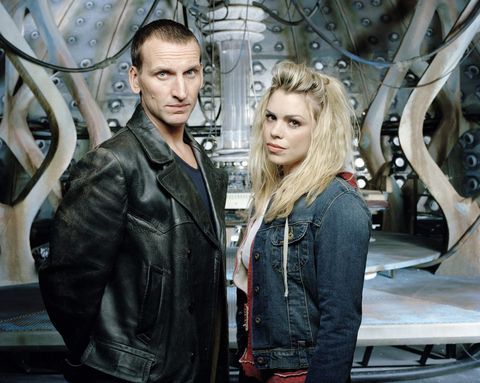
This is kind of a hard idea to articulate, but bear with me. I basically outlined it in the story section above, but you have to approach time as that wibbly-wobbly ball AND accept that time is in flux. We know this because the series has repeatedly and explicitly mentioned that certain events were supposed to have happened, but when the Doctor goes to visit those events, something has changed (hey, even go back to “The Long Game” and “Bad Wolf” - Humanity was supposed to be in the midst of a golden empire, but that had changed). Further to that, we know the Doctor has in the past visited alternate futures that never came to pass, such as when the Seventh Doctor speaks to the Ancient One, the old haemovore, in “The Curse Of Fenric. The Ancient One was from an alternate Earth that had become corrupted by pollution and reduced humanity into vampire-like monsters. This means TWO important distinctions: 1) Time is never set in stone, and 2) Canon doesn’t exist in the time lines, BUT it does exist for the characters because it influences their decisions (so all those people arguing canon doesn’t matter? Yeah it kinda does!)
Okay, continuing on... The Moment is considered one of the most dangerous Time Lord weapons because it is sapient and has a degree of morality. It will allow itself to be used but only after forming a relationship with the user. We’ve already seen some killer Time Lord weapons (esp. The Hand Of Omega in “Remembrance Of The Daleks” and The Nemesis in “Silver Nemesis”), but none had that level of sophistication. The Moment even has the power to break the Time Lock surrounding the Time War. It was mentioned countless times in dialogue that no time traveller could reach the Time War anymore due to this lock.... which makes sense because I believe The Moment was the one that time locked it in the first place. If there is a war being fought between two time travelling sides, what keeps an outcome as final? To truly end the war, the deciding factor would have to cut off all other influences.
So the initial story takes place in the Doctor’s present, as the War Doctor or the Old Warrior (whichever - the script calls him Warrior, but all other media plus the resolution of the story reinforces his moniker of the War Doctor). Because that present has no set future, again due to time being in flux, The Moment would allow for its use. So the Ninth, Tenth, and Eleventh Doctor operated in their time streams having known the truth: The Doctor used The Moment. Gallifrey, the Time Lords, and the Daleks were all destroyed. Now the new story takes place in the Eleventh Doctor’s present. Now that The Moment is in the past, it is no longer in a place of flux and can change the outcome.
So Gallifrey was always saved... but was it always saved before that story? Ugh, temporal mechanics.
But why doesn’t the Doctor remember it?? Because of the flux issue, and we’ve seen this in other multi-Doctor stores (except for “Time Crash” but I’m thinking that’s an exception because it exists within the TARDIS while it is in the time vortex). Remember, the Eleventh Doctor doesn’t remember any of it until the wormhole created by The Moment is opened. And only then does the Eleventh Doctor remember - notice the Tenth does not.
This is the same sort of deal with stories like “The Three Doctors” and “The Five Doctors”. Wouldn’t it make sense in those stories if the current incarnation of the Doctor immediately knows how to deal with Omega, or that Borusa is behind the Time Scoop, since the past versions find out? And there’s two ways to look at it: 1) They DO know, but forget as soon as they’re pulled out of their time streams to deal with the crisis. I don’t put too much stock in this one, but it’s possible. 2) Because the Doctor travels through time, his time stream is constantly under flux, so any crossing of the time stream with himself means that the encounter both did AND did not happen, so it’s an anomaly. This would also explain why we have an alternate Ninth Doctor in “Scream Of The Shalka” (as marvelously performed by Richard E. Grant) - given the context of that story, he was almost certainly the original Ninth Doctor when a previous version of the Time War ended with the Time Lords victorious. Or maybe from a time line with no Time War?
Okay you’ve seen me say “flux” a bunch of times now, so what am I talking about?? Let’s go to an outside source of fiction for an example (and one that the Tenth Doctor used in “The Shakespeare Code”): Back To The Future. When Marty went back in time and saved his father from being hit by the car, he created a whole slew of possible futures. The two primary futures (but certainly not the only ones) were one where George and Lorraine do not get together, and one where they do. Both have their own details that are fleshed out with slight changes to the developing situation (indeed, the “new” present Marty goes back to is a variation on one). When Marty notices his picture has his siblings vanishing, and he himself is beginning to vanish, this is due to that flux. The future is in the process of being changed with no set outcome defined.
Does that make sense? I hope so. Anyway that’s why canon does and does not matter, and why the previous incarnations don’t keep their memories. And that’s why Gallifrey survived even though it didn’t.
And Another Thing:
The Tenth Doctor saying “Cause I don’t want to go” is just awkward fan service.
The Ninth Doctor: “You think it'll last forever. People, and cars and concrete. But it won't. One day, it's all gone. Even the sky. My planet's gone. It's dead. It burned like the Earth. It's just rocks and dust. Before it's time.” Rose: “What happened?” The Ninth Doctor: “There was a war. And we lost.” Rose: “A war with who? What about your people?” The Ninth Doctor: “I'm a Time Lord. I'm the last of the Time Lords. They're all gone. I'm the only survivor. I'm left travelling on my own because there's no one else.”
#doctor who#John Hurt#christopher eccleston#david tennant#matt smith#war doctor#ninth doctor#tenth doctor#eleventh doctor#TARDIS#canon#Regeneration#review#gallifrey#time war#the day of the doctor
4 notes
·
View notes
Text
Doctor Who Regeneration Series Revisited: The Eighth Regeneration
youtube
Ohila: “She would beg your help, as we beg your help now. The universe stands on the brink. Will you let it fall? Fast or strong, wise or angry. What do you need now?” The Eighth Doctor: “Warrior.” Ohila: “Warrior?” The Eighth Doctor: “I don't suppose there's a need for a doctor any more. Make me a warrior now.” Ohila: “I took the liberty of preparing this one myself.” The Eighth Doctor: “Get out. Get out! All of you. Will it hurt?” Ohila: “Yes.” The Eighth Doctor: “Good. Charley, C'rizz, Lucie, Tamsin, Molly, friends, companions I've known, I salute you. And Cass, I apologize. Physician, heal thyself.”
Story (from “Night Of The Doctor):
A gunship is heavily damaged and on a collision course with a planet. The lone occupant, Cass, had seen to the evacuation of the rest of the crew but was left behind. Trying to balance sending out a distress call, debating the ship’s computer, and fighting the controls for some form of navigation, she is surprised by the Eighth Doctor’s appearance behind her.
The Doctor tries to help regain control of the ship, but soon finds that it is hopeless. Cass explains the situation and he resolves to have the two escape in his TARDIS. Upon seeing the TARDIS, Cass quickly deduces what it is and who he is. She refuses his aid and he is shocked.
Cass is suffering trauma from the ongoing Time War between the Time Lords and the Daleks, and will not accept any help from the Doctor. He pleads with her to let him rescue her, but she seals him in the hold with the TARDIS. While he tries to convince her to open the door the ship crashes on the planet below, killing both the Doctor and Cass.
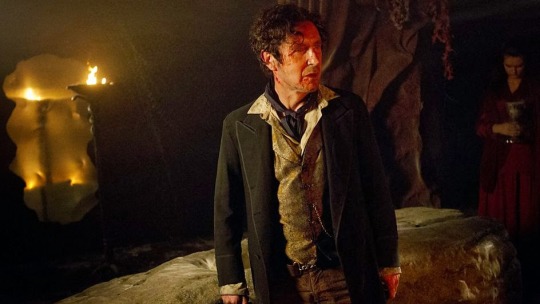
Fortunately the planet is Karn, and the Sisterhood of Karn are expecting the Doctor’s arrival. Using their Elixir of Life, they revive the Doctor but only for four minutes. Unfortunately Cass is too far gone to be saved. Ohila of the Sisterhood pleads with the Doctor to join the Time War and end it, knowing that if anyone can do so it would be him. But the Doctor refuses. He explains that he helps where he can, but will not engage in warfare.
Ohila counters that the Time War is so destructive that there won’t be much left of the universe by the time it finishes. The Doctor finally reconsiders, resolving the end the Time War by whatever means he can. Ohila brings another elixir to trigger his regeneration, but by design it will allow him to become a warrior. Taking the elixir he regenerates painfully. Putting on Cass’s baldric, he denounces his name of the Doctor and chooses to be the Warrior, setting off to go join Gallifrey and defeat the Daleks.
Production:
Since the relaunch of the series in 2005 there was a good deal of fan speculation as to what happened to the Eighth Doctor. The general consensus, though unconfirmed until the Tenth Doctor’s run, was that he had regenerated at some point into the Ninth Doctor, and fairly recently before the series premier of “Rose”. Once we began to learn more during the Ninth Doctor’s run about the Time War, it seemed to be fairly obvious that it was the Eighth Doctor who had fought in the war and that he had regenerated into the Ninth right at the end.
This assumption began to inform the writing of the series. In episodes like “Human Nature” and “The Next Doctor”, even up to “The Eleventh Hour”, any flashbacks or references would show the Eighth Doctor and the Ninth with nothing in between. Coming up to the 50th anniversary of the show in 2013 during the Eleventh Doctor’s run, showrunner Steven Moffat began conceiving a story that would honor the legacy of the show and finally fill in the history of the Time War.
There was a problem though. During the writing of the script, the producers were able to secure Matt Smith (as the Eleventh Doctor), David Tennant (as the Tenth Doctor), but not Christopher Eccleston (as the Ninth Doctor). Eccleston gave it serious consideration when approached and at one point I heard that he had requested that one of the directors from his tenure be brought back to direct as a condition.... but I can’t find any reference to that (which is why I’m not sure which director it was he wanted - Joe Ahearne maybe?). From all that I can see in various articles, Eccleston was still feeling slighted with how he was treated during and after his stint on the show by the production team. He even felt that his own feelings were being mischaracterized.
So ultimately he declined. This meant massive rewrites were needed with less than a few months to pull it all together. For the May 2013 broadcast of the last episode of Series 7, “The Name Of The Doctor”, the last shot of the episode features an appearance of an incarnation of the Doctor never seen before buried deep in the Eleventh Doctor’s mind: The War Doctor. Fan speculation went nuts.
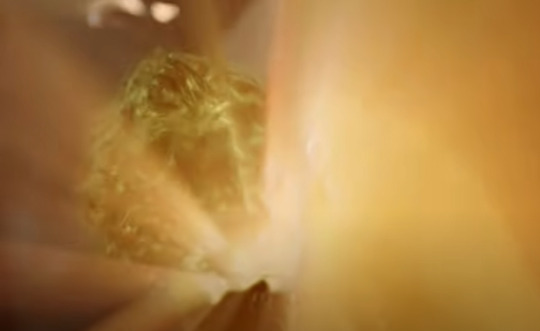
To lead into “The Day Of The Doctor”, the 50th anniversary story, Moffat and the rest of the production company decided to also release two mini-episodes to whet the appetite of the fans: “The Last Day”, which takes place on Gallifrey and does not feature the Doctor, and “The Night Of The Doctor”. Paul McGann was secretly recruited to reprise his role as the Eighth Doctor to explain the Doctor’s involvement in the Time War and who the War Doctor was.
The short mini-episode aired on November 14, 2013, online and just over a week away from the 50th anniversary special. All told, it is about six and a half minutes, and in that time it accomplishes everything the production team hoped. Fan reaction was overwhelmingly positive, with many praising McGann’s return to the role after 17 years (televised anyway; he had been doing the audio dramas for quite a few years). McGann enjoyed the short as well and even noted that the version of the costume he wore in it was by far his favorite.
As far as the regeneration goes, it is completely in line with the way regenerations are shown since the relaunch of the series with a yellow glow radiating outwards during a video mix. Except that since John Hurt was already quite elderly and the appearance of the War Doctor is to him as a younger man, we cut away from seeing him directly. Instead we get his face reflected in a surface, de-aged through CGI. Although I’ll mention this in future articles, I should note that when the show relaunched in 2005 there was a deliberate choice to have the regenerations be consistent in terms of effects. So we’ll see some variation of this effect each time going forward.
Analysis:
I remember when this special aired quite distinctly (and I’m also not ready to talk about how that was almost 10 years ago). I was at my Mom’s apartment just surfing the web when I saw several people sharing the video on Facebook. I called my brother over to show him and we began watching it. Within a minute or so, my stepfather couldn’t believe his ears at the voice of Paul McGann reprising the role of the Doctor and came rushing over. So we restarted the video and away we went.
There was no indication this was coming, really. I had been keeping close tabs on the news of the series and the releases, and I was completely blindsided. And that was by design, so I have to give hearty props to Moffat and his team. It would also have been so tempting to indulge and make a full length episode, but they showed remarkable restraint by ensuring that this was just supplementary material. You didn’t need to see it to watch the upcoming special, but it was a treat for Whovians to enjoy (and fill in some plot points).
The story itself is fairly bare bones, which it should be, and the focus is all on continuity. So let’s look at that. The first and most tangible link to the classic series is the setting of Karn. It has only been seen once before, and that was with the Fourth Doctor story “The Brain of Morbius”. Morbius was a Time Lord criminal who was basically vivisected by the Time Lords as punishment. A mad scientist and one of his disciples decided to try to revive Morbius by building him a new body and the Sisterhood of Karn have command over life and death (mostly anyway). It’s a very rich story on its own with continuity jampacked into it.
More on Karn. The planet was said to be “only a few billion miles from Gallifrey” in “The Brain of Morbius” which has led many to believe that it’s in the same system as Gallifrey. This would make sense, as the Time Lords would often seek out the Sisterhood’s aid for regeneration difficulties. The Sisterhood is very well-versed in time as well and would be the most logical choice to serve as observers to the Time War. The Sisterhood also owe the Doctor a tremendous debt of gratitude for not only helping them against the machinations of Morbius, but also in reigniting their Sacred Flame (although it was a silly solution).
Now what had the Eighth Doctor been up to this entire time? Well look no further than the Big Finish audio dramas! Because before the Doctor drinks the regeneration potion, he salutes his companions from the audio dramas by name. So this seems to canonize those dramas. Since the air date of this episode, further audio dramas from this time have been produced.
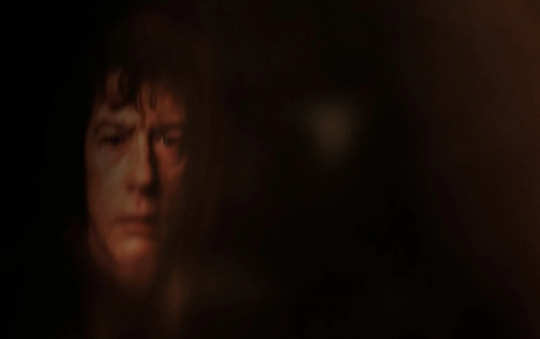
Now hold up.... I can already hear some of you getting riled up and cracking your knuckles for a keyboard war. “Canon doesn’t matter in Doctor Who!” you may be ready to say. And this is SUPER complicated, so I’ll say both yes and no. The short answer is that no single timeline will definitively exist, BUT the effects from those timelines AFFECT and INFORM the actions of the Doctor - so they are STILL relevant. The best example off-hand is from “The Curse Of Fenric”. Fenric recruits the Ancient Onem a haemovore from an alternate Earth where pollution and destruction have reduced the planet to a wasteland. This never came to pass but the Doctor had visited (and perhaps prevented) the time line and Fenric was able to access it. Anyway I think I’ll write an article about Doctor Who canon after this regeneration series. You may think it’s a waste of time but fans get really heated about it, and a little unnecessarily defensive.
On that note I do think it’s worth mentioning the story from the novels, because not only does it inform some aspects of the Time War but it also dodges some of the canon arguments. All through out the Eight Doctor’s travels, he was noticing the sudden appearance of paradoxes and traps laid out for him, in such a devious manner that it was undoubtedly from an enemy he had never before faced. Soon the enemy is revealed as the Faction Paradox; a segment of Time Lord society who had decided on anarchy and felt the Time Lord order must be eradicated. A brutal civil war ensued, and the Doctor came face-to-face with their leader, Grandfather Paradox, who was the embodiment of a paradox (and may be an alternate version of himself). It was revealed that he had travelled back in time and murdered his grandfather, and the resulting paradox had corrupted him entirely.
It is revealed in the last novel of the Eighth Doctor series, “The Gallifrey Chronicles” that during the civil war between the Time Lords and the Faction Paradox, the Doctor spearheaded the defense. In a moment of desperation, when it seemed all of creation was on the point of destruction, the Doctor destroyed the Faction entirely but at the expense of annihilating Gallifrey as well. The Doctor, as the lone survivor, had uploaded the Matrix into his mind to save what was left of Time Lord society. However the process gave him selective amnesia, which burdened him through the rest of the novels. Another Time Lord in exile, Marnal, builds a visualiser to witness the past and future events surrounding the Doctor and Gallifrey, and decides he must kill the Doctor as punishment. While watching through the future events, he notices several time streams stemming from the Eighth Doctor, with several alternate Ninth forms.
Now if the Faction Paradox have masterminded paradoxes and meddled directly in the Eighth Doctor’s life, we can easily say that the original time line was the audio drama line and that the novel line is an alternate time stream. If Marnal saw the Time Lords restored, it’s possible that the Faction Paradox were erased from existence in the future and the original time line was restored. This also helps explain the official BBC drama “Scream of the Shalka” released in 2003 - it was (up to that point) an official continuation of the series with a new Ninth Doctor played by Richard E. Grant. Now with this Faction Paradox meddling that story would be from a timeline where the Time War never happened, as the Doctor is on a (begrudging) assignment from the Time Lords.
It’s a lot to take in, I know, so suffice to say if you want to ignore the novels that might reduce some of the headache. And then you can ignore “Scream Of The Shalka” too. And there is some question as to how the Faction Paradox war would then lead into the Time War... maybe one of the sides invoked the Daleks as a weapon? Who knows. With the Faction Paradox, the Time Lords, AND the Daleks all constantly rewriting history, anything could have happened.
And Another Thing...
It seems strange to me that the Daleks never destroyed Karn.
Ohila: “Is it done?” The War Doctor: “Doctor no more.”
#doctor who#Eighth Doctor#war doctor#john hurt#TARDIS#Regeneration#review#the night of the doctor#Paul McGann
1 note
·
View note
Text
Doctor Who Regeneration Series Revisited: The Seventh Regeneration
youtube
The Seventh Doctor: “Whatever you’re about to do, stop!” Grace: “Mr. Smith, you’re going to be all right.” The Seventh Doctor: “No, I am not human. I am not like you!” Grace: “Nobody’s like you, Mr. Smith…”
Story (from “Doctor Who”):
The Master has been caught and placed on trial on Skaro. Before the Dalek’s execute him, he asks that his remains be taken back to Gallifrey by the Doctor. The Daleks (for some odd reason) grant this request.
As the TARDIS heads to Gallifrey, a slimy creature breaks out of the box containing the Master’s remains and sabotages the TARDIS. The ship loses its bearings and crash-lands in San Francisco in 1999. The Doctor realizes he needs a to realign the TARDIS’ timing mechanism and the closest approximation on Earth is a Beryllium Atomic Clock. As he steps out of the ship he is caught in the cross-fire of a gang shooting.
One of the gang members, Chang Lee, attends to the Doctor and has him taken to a hospital. A diagnosis shows two bullets in his leg and one in his shoulder. While treating him the staff check his heart rate, which is more than double what it should be. Taking an x-ray of his chest reveals two hearts but the staff assume a double exposure and order another machine.
The resident cardiologist, Dr. Grace Holloway, inserts a probe into his circulatory system to locate the source behind his erratic heart rhythm. Unfortunately, she critically wounds the Doctor while lost in his alien arteries and he dies on the operating table.

After his body has been wheeled into the morgue Grace examines the x-rays and determines that it wasn’t a double exposure. She’s astounded by this amazing development and eagerly awaits the autopsy.
While in the morgue the Doctor regenerates, a process significantly delayed by the anesthetic in his system. When he regains consciousness he realizes he has no memory. He beats down the door and stumbles through the hospital trying to get his bearings. Soon he finds Grace and, recognizing her, follows her in an attempt to get his memory back.
Meanwhile, the creature that is the Master has entered the body of Bruce, the paramedic. With that body rapidly decaying the Master begins to enact a plan to steal the Doctor’s remaining regenerations even if it means destroying the Earth in the process.
Production:
In 1989 BBC1 controller Michael Grade finally got his wish: Doctor Who was taken off the air. The 26th season saw John Nathan-Turner stay on as producer even though he had tried to get out of it twice. Andrew Cartmel had been script editor for the entire run of McCoy’s Doctor and was keen to stay on for at least one more season. In fact, scripts were already under consideration.
The last season of Doctor Who was an odd one. There were four stories, and they focused on the “darker” Doctor and a more complex Ace (his companion). Ace was a very suitable replacement for Mel. Where Mel was a walking scream machine, Ace was very three-dimensional and was even brought to the writers during pre-production to talk about character arcs. The Doctor’s costume became darker and he alluded to being more than just a Time Lord. He became more manipulative, often aware of events before they happen, and orchestrating them to happen properly.
Unfortunately many of the plot points that were being developed including “who the Doctor really was” were dropped when production of the series ceased. The final story of the series, “Survival”, depicted the Doctor confronted by the Master once more whom we hadn’t seen since “The Trial of a Time Lord” back with Colin Baker.
During the 90’s there were many attempts to bring Doctor Who back. In 1996 Philip David Segal was very interested in being the one to spearhead the project, but it looked like the BBC wasn’t going to play ball so he began shopping around for anyone else who might be interested. This naturally led him to the US, where he thought the series might do well, especially with the larger budgets that American networks grant their shows.
The only network who was even remotely interested was Fox. But there was a catch; they first had to produce a back-door pilot, a television movie that could serve as a first episode. That way Fox could assess the ratings and commission a series based on how well the TV movie did.
With a budget of $5 million Segal was able to get the BBC on board (as the BBC had all the licenses) as well as Universal. $1 million was to be spent on the set of the TARDIS interior alone. This interior became a tremendous improvement over the previous version, with a steampunk theme and a grandiose cloister bell room, containing the Eye of Harmony (more on that later). Interestingly some time after production the set was stolen from storage.
Matthew Jacobs was hired to write the script and Segal dictated quite a few terms. He believed Doctor Who had lost its footing in the 80’s and wanted to return to the mysterious mythology of the Time Lords. With the visuals he wanted to do away completely with vibrant colours and question marks. As such the Eighth Doctor would dress in a Victorian manner, reflecting the first few Doctor’s costumes.

For casting Paul McGann was selected to be the new Doctor and Segal made it clear that he wanted a regeneration scene. That required pulling Sylvester McCoy back into the role, which he was more than happy to do. In the part of the Master Segal cast American actor Eric Roberts who you may recognize as ‘that guy from a couple of good movies and lots of really bad ones. Daphne Ashbrook was cast as Grace, the Doctor’s companion for the story, and even during production it was known that she would not continue on if the series was picked up. Interestingly enough Ashbrook was one of very few actors who had appeared in Star Trek and Doctor Who up to that point (she played the titular character in the DS9 episode “Melora”). Since then there has been far more crossover.
Recognize the font for the title? It’s the same one that was used for Jon Pertwee’s era. There was initially going to be a new theme tune composed as well, hence the credit given to John Debney, but at the last minute a new arrangement of the old theme tune was used.
The movie was shot in Vancouver, BC, and even aired in Edmonton on CityTV first before the Fox broadcast and the UK broadcast. It flopped in the US and Fox nixed the idea of financing the series (oddly enough, I am totally unable to find out what the ratings were). However in the UK it scored over 9 million viewers thus showing the BBC that there was significant interest in the program…but more on that in future articles.
As for the regeneration itself Segal was very interested in showing more of the process. He thought that using a light and a video mix was a cheap way to do it and wanted to take advantage of the budget to show a genuine morph. Throw in some electricity, and some cuts to Will Sasso watching Frankenstein to serve as tongue-in-cheek exposition, and the regeneration was completed.
Analysis:
First off, the regeneration.
Wow!
What a spectacle. Segal hit the nail on the head when he wanted to show the process and not just disguise a changeover between the two actors. In terms of explaining it within continuity we can go for the easy explanation: the anesthetic. Not only did it delay (and almost destroy) the regenerative process but we can speculate that it hampered the regeneration. Hence why we see and hear bones grinding and the muscles stretching and morphing. So I’ll give a hearty bravo to that.
Now for the rest of the story.
Hmm.
On the whole I think it’s okay. As someone who has a fair bit of knowledge about the mythos of the show I can get into it. But the terminology and the technology are just kind of thrown at the audience with a half-explanation (more of a “just go with it”), and I can see that as being really confusing. For that matter it’s too short. At just under 90 minutes they cram way too much into it. Slap on another 20 minutes or cut some of the chaff; either way, rewrites were needed.
On to specifics. The casting is pretty good all in all. Paul McGann is captivating as the Doctor; he might even be one of the best (seriously!). He brings a strength and a vulnerability, with just a little wacky thrown in. Daphne Ashbrook as Grace certainly compliments him as an intelligent and resourceful woman as Lord knows we don’t need another Mel…ever again. I question the casting of Eric Roberts as the Master. He can be a little menacing at times but on the whole he’s just a little too over-the-top. Previous incarnations of the Master were at their best when they were calm and in the shadows. Roberts walks around like the Terminator, and then dresses up in Gallifreyan robes at the end. Why??
On the subject of the Master, one thing I DID like was his glowing eyes. While casual watchers might assume that it is his “evil essence” or whatever the last story of the series, “Survival”, involved a planet that possessed anyone on it and turned them into Cheetah People. One of the first symptoms was to get their eyes and the longer you stayed on the planet, the more long-term the effects. The Master was on there for quite a while and we can infer that he is still infected (although for him the infection may be permanent). This may not have been intended by the writers but it seems too extraordinary a coincidence.
You may be asking why a Time Lord can apparently survive being dematerialized by the Daleks and take on the form of a slimy snake creature. Well you can choose the easy answer and say “Because he’s EVIL.” But many writers have tried to explain this in more concise ways. In the novel ‘The Eight Doctors’, which takes place directly after the movie, there is a flashback which shows the Master contemplating how he can get more regenerations and visiting a world where such creatures are used to prolong life – they can store neural energy and then they seek out a new host. I find this has the most weight behind it because it is written by Terrence Dicks (remember that guy? Former script editor, writer of many Doctor Who apocrypha, and principle supporter of the season 6B theory with the Second Doctor).
Moving to the TARDIS I’m pretty happy with the change. The steampunk look is a good one and very appropriate for the ship. It is interesting to note that there are some novels that implicitly state that only Time Lords can truly understand the complexity of the TARDIS and any other race would go insane even looking at it. As such, TARDISes generate telepathic fields to alter perception of the craft. As much of a stretch as this may seem remember that it stated explicitly in the series (both old and new) that the TARDIS translates language for anyone who travels in it by telepathy. So it’s not too much of a jump of logic.
A lot of fans were puzzled by the appearance of the Eye of Harmony within the TARDIS. Whenever it has been seen or mentioned it has been on Gallifrey. Which makes sense given it contains a singularity. As such it has been dismissed as a link to the Eye which makes sense since all TARDISes draw their energy from the Eye. And this isn’t even the first time the Master has tried to use to Eye to grant him more life (see the Fourth Doctor story “The Deadly Assassin”). But why on Earth does it need a human eye to open? I’m going to wage a bet that it doesn’t actually; it just won’t open for the Master.
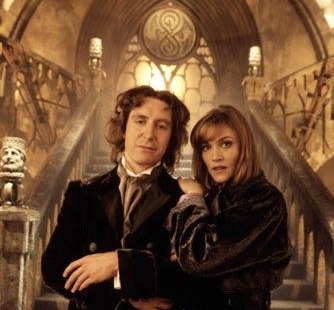
Also…what’s this about the Doctor being half human?? Many writers have tried to explain this with excuses being that he used the chameleon arch right before his regeneration (see the Tenth Doctor story “Human Nature”) to only that regeneration being half human (as Romana seemed to be able to change her species while trying on regenerations) to him having a human mother from the Victorian era (and we just didn’t know this whole time). Now on the other hand in the Tenth Doctor story “Journey’s End” a duplicate Doctor is created who is half human from his companion Donna’s genome, and no one is more shocked at being half human than he is! On that note go to the BBC’s official Doctor Who website and if you read the FAQ it confirms that the Doctor is half human. BUT if you read the trivia for this story it states explicitly that this episode lays that issue to rest as the Doctor can’t be half human. So if even the BBC website is divided on the issue I doubt we’ll see any closure anytime soon. Personally…can’t we treat it like Highlander 2 (ie It never happened)?
Now another thing I liked was how the Master couldn’t stay in a human body for long; he was burning it out. We don’t see this again until “Journey’s End”, when Donna has the knowledge of a Time Lord stored in her head (a Time Lord – Human Metacrisis). It begins to burn her out and will kill her but the Doctor wipes her memory to prevent that from happening.
How does the Master intend to use the Eye to take the Doctor’s remaining regenerations (or his “body”)? Well, I’m not too sure but I would place a wager that he’s attempting to absorb the energy of the Time Vortex and while in the process of doing that he’s swapping places with the Doctor. We see the full power of the Time Vortex in the Ninth Doctor story “The Parting of the Ways”, when Rose has absorbed the power of the Vortex. It allows her to bring Captain Jack back to life and sure enough in this story the Vortex brings Grace and Chang Lee back to life as well (although it is the TARDIS that controls it). It even uses the same gold dust effect.
One last thing: the newly regenerated Doctor pulls the lost probe out of his chest while sitting in Grace’s car. A gaping wound like that should slow someone down but we can again safely assume that the regeneration effect has lingered long enough to quickly heal such an injury (a la the Tenth Doctor story “The Christmas Invasion”). In fact he seems to have enough energy built up that he was able to batter down a sealed steel door in the morgue.
Man…there’s a lot to this story. Again although it is interesting to fans of the series it is a detriment to the accessibility of the story for new viewers. So it’s a good watch if you have a few stories under your belt, and it’s a shame we didn’t see more of McGann in the role.
Or did we? Stay tuned for next time.
And Another Thing…
Yee Jee Tso, who played Chang Lee, can’t act to save his life. Grace: “Two hearts. You were right... who are you?” The Eighth Doctor: “I was dead too long this time. The anesthetic almost destroyed the regenerative process.” Grace: “Oh, yeah. Right... Look, I'm going to take some of your blood and find out what's going on here.” The Eighth Doctor: “No, Grace. Don't you see? I have thirteen lives...” Grace: “Please! Don't try and tell me that you came back from the dead. Sorry, the dead stay dead. You can't turn back time.” The Eighth Doctor: “Yes, you can.”
0 notes
Text
Doctor Who Regeneration Series Revisited: The Sixth Regeneration
youtube
Story (from “Time and The Rani”):
As the TARDIS flies through time and space, energy bolts start pounding it, forcing it down to the planet Lakertya. A woman forces her way inside, where the Doctor and his companion Mel are unconscious. The woman, a renegade Time Lord who calls herself the Rani, commands a creature to take the Doctor back to her lab. The creature rolls the prostrate Doctor over to reveal that he is regenerating.
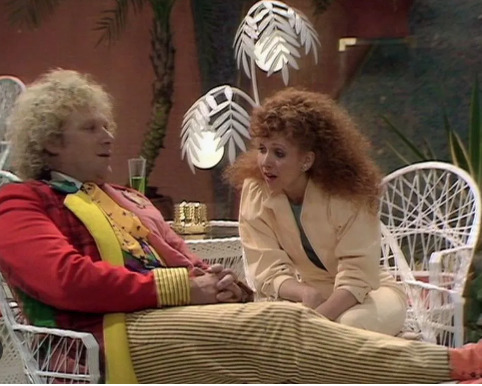
As the Doctor snaps back to consciousness in the Rani’s lab, he immediately recognizes her and determines that, despite any reason she’s brought him there, he doesn’t want any part of it. The Rani has the Doctor stunned and then injects him with a substance to render him with amnesia.
Disguised as his companion Mel, the Rani tricks the Doctor into completing her machine and aiding in her experiment. But what the Doctor in his brain-scrambled state doesn’t realize is the Rani intends to use kidnapped geniuses to create an amalgam intelligence to harvest a forbidden power.
Production:
From 1985 to 1987 Doctor Who was in serious trouble. In Colin Baker’s first year complaints about the violence and the tacky look of the series had reached its apex. Although the complaints were nothing new, and had indeed plagued the program since Tom Baker’s time, the one hearing the complaints had changed. BBC1 Controller Michael Grade made no secret that he despised the program and thought it had long run its course. Further to that, he hated Colin Baker’s portrayal of the Doctor.
As stated last time it should be specifically noted that Colin Baker’s performance wasn’t wholly his fault; remember, this was the direction that producer John Nathan-Turner wanted the program to go in. As such Nathan-Turner took the criticism to heart and thus began a long fight between him and the BBC for the program’s continued run. Michael Grade insisted the ratings were likewise slipping, although this would later prove to be inaccurate. After Colin Baker’s first year, the series went on hiatus.
Scripts had been written and preproduction had begun but suddenly everyone on the series found themselves without a job. Appeals went out to the public to save the program, and this spearheaded into a charity song released by some of the cast and crew (and composed by Hans Zimmer!) called “Doctor In Distress.” The single didn’t really chart, and was on the whole pretty silly, but after 18 months it seemed Michael Grade was willing to bring Doctor Who back on the air.
However there were concessions that had to be met. First off Grade wanted Colin Baker off the show. Baker had expressed interest in remaining in the series for quite a few years, even taking a stab at surpassing Tom Baker’s run, but his second full season would be his last. Secondly the violence had to be cut down. Thirdly ratings had to improve or that would be the end of it. John Nathan-Turner agreed, but was incensed by the process and made known that he would leave after the season was complete.

As such script editor Eric Saward and Nathan-Turner modeled a season long story called “The Trial of a Time Lord.” More humour was introduced, and a new companion came on halfway through: Mel played by Bonnie Langford. Nathan-Turner had seen her work on children’s programs and once heard her scream. He felt that her scream was perfect for the program.
More on THAT later.
The ratings were good and it seemed Doctor Who would keep going. Nathan-Turner helped the production team find Baker’s replacement before his departure. The man they selected was Scottish actor Sylvester McCoy. McCoy was well-known as being comic relief characters in many Shakespeare productions and it was felt his physical humour and off-beat quirkiness could really be an asset to the program.
McCoy was a fan of the program, and came on board with a host of ideas. First and foremost he wanted to bring a darker edge to the character and dress him in darker and more subdues tones (sound familiar?). He wanted the Doctor to seem harmless and laughable but begin to show a deeper and more complex personality. And this was what wound up happening during McCoy’s run. His costume started light and goofy but slowly transformed into something darker, as did the Doctor’s personality. Tragically the ideas that Colin Baker brought to the table but wasn’t allowed to use wound up being McCoy’s Doctor’s strengths. To top it off McCoy brought to the series his favourite hat, which would become heavily associated with his portrayal of the Doctor.
But Michael Grade wasn’t through yet. Not only was he ultimately unhappy with McCoy’s performance and the direction the series was going in, but he managed to persuade Nathan-Turner to stay on as producer – or lose his job at the BBC entirely.
As for the regeneration itself, because the production team was in such a state of flux (in fact, Saward had passed away mere months before) no good scripts were ready and there was a miscommunication with Colin Baker regarding the regeneration. As such the regeneration was quickly inserted to the beginning of the first episode of the season with McCoy in a wig and Baker’s clothes for the regeneration. As such the only video mix present is McCoy (with his face blurred in light) in the wig, and then the wig fading out with McCoy’s face becoming clear. Not amazing but functional. Colin Baker was apparently very willing to do the regeneration scene, as he still was fond of his time on the series despite the trouble the BBC gave him, but the impression the production team had was that he had refused.
McCoy would go on to play the Doctor until the series’ cancellation in 1989. But that would not be the end of McCoy’s tenure as the Doctor.
Analysis:
So why did the Doctor regenerate?
Watching the scene we see that both the Doctor and Mel have been thrown to the floor of the TARDIS and are unconscious. But while Mel is merely stunned, the Doctor has been fatally injured. This has been the source of much fan speculation. Personally I have been of the opinion that the Doctor was electrocuted at the console when the TARDIS was struck by the Rani’s weapon, or maybe he even cracked his neck on the way down.
The most noteworthy explanation I have heard was through the book series Doctor Who – The New Adventures, that were published between 1989 and 1996, and followed the Seventh Doctor. In many of the books it was implied that the Sixth Doctor (or even the Watcher version of the Seventh Doctor) forced the regeneration to prevent himself from eventually becoming the Valeyard, who was the villain during “The Trial of a Time Lord” and was revealed to be an alternate future version of the Doctor. As such the attack by the Rani was purely coincidental and bad timing at that.
The regeneration itself is okay. It’s not the worst by far, and it certainly hits the right marks, but there’s very little emotional investment. Conversely it is quite mysterious and an interesting lead-in to the season.

The story of “Time and the Rani” is a little silly, and could have been pretty good. I feel it gets a little hampered by Mel being useless and all that running around. But it’s nice to see a character like the Rani again. Where the Master is just evil and likes to kill, the Rani is a spin we haven’t seen too much before: she’s a scientist first and foremost but has no ethics. She will do whatever she can to accomplish her objective. She might be the strength of the story behind McCoy. McCoy is excellent. Every time he’s onscreen he’s interesting and captivating.
The remixed starting sequence is something that I’m pretty pleased with also. I liked the “Trial of a Time Lord” remix but this was a clear departure while still honouring the old melody fans were used to. The title is a little dated though; every time I look at it I think of an 80’s music video review show.
I’m also pretty pleased with the clearly improved special effects. There was even a noticeable improvement during the previous season but I’m less likely to apologize for the effects when others are watching it. It’s also worth noting that where the Second Doctor had to compete with “Star Trek” in the UK, at this point the Seventh Doctor now had to compete with “Star Trek The Next Generation” in both the UK and North America.
And Another Thing…
John Nathan-Turner was out of his mind. Every time Mel opens her mouth, I want to shoot myself.
The Seventh Doctor: “Well, time and tide melts the snow man.” Mel: “Waits for no man.” The Seventh Doctor: “Who’s waiting? I’m ready.” Mel: “You’re certainly going to take a bit of getting used to.” The Seventh Doctor: “I’ll grow on you Mel, I’ll grow on you.”
#doctor who#sixth doctor#seventh doctor#time and the rani#colin baker#sylvester mccoy#TARDIS#Regeneration#review
0 notes
Text
Doctor Who Regeneration Series Revisited - The Fifth Regeneration
youtube
Peri: “Where is it??” The Fifth Doctor: “Where’s what?” Peri: “The bat’s milk!” The Fifth Doctor: “Finished. Only enough left for one.” Peri: “We have to get more!” The Fifth Doctor: “Too late Peri. Going soon. Time to say goodbye.” Peri: “Don’t give up! You can’t leave me now!” The Fifth Doctor: “I might regenerate…I don’t know… [sinks to the ground] Feels different this time…”
Story (from “The Caves Of Androzani” and “The Twin Dilemma”):
The TARDIS lands on Androzani Minor, where a dispute has escalated into a full-blown guerilla war between the drug lord Sharaz Jek and the wealthy industrialist Morgus over the drug Spectrox, which can halt the aging process. The Doctor and Peri are exposed to a white fungus in the caves, which is soon discovered to be the unrefined drug known as spectrox toxaemia. Direct exposure is fatal and can only be counteracted by the milk of the Queen Bat that leaves deep in the caves.
Unfortunately the Doctor and Peri find themselves captured by first the guerilla army and then the madmen Sharaz Jek, who finds himself deeply infatuated with Peri. Things get worse when the Doctor is kidnapped and sent to Androzani Major. Getting embroiled in the politics of the drug cartel, the Doctor is finally able to get back to Minor in time to see the war reach its climax. Soon casualties start piling up, and the Doctor must go down into the depths of the caves where very little oxygen exists.
Returning from his trek the Doctor discovers everyone has been killed except for Peri, who is near comatose in Jek’s lair. He carries her back to the TARDIS but while trying to open the doors accidentally spills some of the milk, leaving only enough for a single dose. He gives it to Peri, who recovers in time to watch the Doctor regenerate (while images of past companions and the Master haunt him).
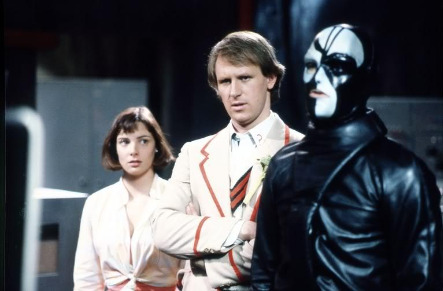
The Doctor seems to have no difficulty with the regeneration and proclaims to be almost completely free of any hassle. However the regeneration proves to be unstable and he goes into manic states, even attempting to strangle Peri in a paranoid frenzy. Upon realizing what he is turning into the Doctor proclaims that he must seek refuge on Titan 3, an isolated asteroid, where he intends to become a hermit and a monk with Peri as his disciple. Peri, meanwhile, has been angered and saddened by the sudden change in the Doctor’s temperament and wishes to leave.
Upon landing on Titan 3 the Doctor and Peri discover a crashed police fleet from Earth with only one survivor, Lt. Hugo Lang. Lt. Lang recovers from the trauma to explain that he was sent to recover a set of genius twins that were kidnapped. Picking up on the mystery the Doctor, Peri, and Lang track down the teens that have been kidnapped by one of the Doctor’s old mentors from Gallifrey and a giant telepathic slug ruling over a devastated world. The slug, Mestor, has a plan to move planets in such a fashion as to spread his army across the universe and he needs the twins’ mathematical genius to do it.
Production:
You may have noticed that most of my production notes have had the same general tone: the show is getting stale, the production team wants new ideas, or they’ve changed and want to change the show to reflect that. Well that’s not actually the case this time. The producer is still John Nathan-Turner and the script editor Eric Saward. The ratings could have been better, but were somewhat consistent. There was no immediate need to change things in 1984 after three years of the Fifth Doctor.
So what happened? During the 20th anniversary a special was released called “The Five Doctors” which saw all five past Doctors reunited in an epic story regarding many of the Doctor’s past companions and enemies, in a story regarding a traitor on Gallifrey (well…mostly. Tom Baker declined to participate, so there were significant rewrites in the early stages and clips from an unfinished story to explain his absence. Also William Hartnell had died, so Richard Hurndell played the First Doctor). During that time Peter Davison got to meet and work with the Doctor he grew up watching: Patrick Troughton. It was during this time that Troughton convinced Davison that three years is really the ideal for playing the role. He probably noted Baker’s decline in participating, as Baker had played the role for so long he probably didn’t want much to do with the series (although Baker would later regret this – he mellowed out in his old age), and maybe even Pertwee’s hesitation in participating.
As such, Davison stated that his third season would be his last. Nathan-Turner took it in stride and began shopping for a new Doctor. And that would lead him to Colin Baker, a quirky actor who had previously played the Captain of the Guard for the Time Lords Maxil in the story “Arc Of Infinity” (where he got to shoot the Fifth Doctor!). As Davison’s last season progressed he noted the strength of some of the stories, including “Caves Of Androzani”, causing him to offer to stay on another season. But by that point it was too late and so Davison’s departure carried on.
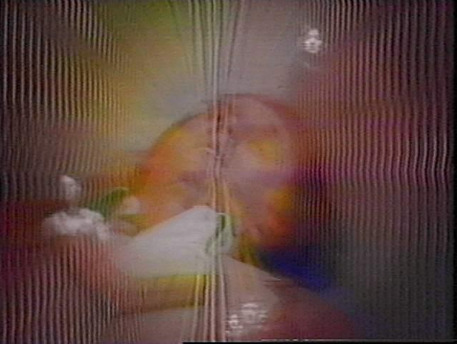
The regeneration was probably the most technically complicated one so far (not that this was an accomplishment) and also the most layered. The Doctor collapses on the ground and his image becomes distorted. Specially recorded inserts are projected over, and then rotate around, him of past companions urging him to fight and survive. Finally the distortion becomes violent and colorful as the Master urges to Doctor to die. As his laughing face dominates the screen the distortion becomes more colorful and jagged and, with a sudden boom, ends. Colin Baker sits up suddenly, inspecting his hands. Video mix has been replaced with a special effects overlay. Director Graeme Harper had been with the series quite a while by this point, knew that the regeneration had to be a spectacle, and that he had to bring something new to the table.
Interestingly “Caves Of Androzani” was not the last story of the season. Nathan-Turner wanted to try having a full story featuring the new Doctor end the season, giving viewers a sneak peek of what to expect. Although an interesting idea, the next story (“The Twin Dilemma”) was weak and turned a lot of viewers off. But let’s backtrack a bit.
Colin Baker had been a fan of the series also and when cast as the Doctor he brought some ideas to the table regarding his character. Firstly he wanted to dress in all black, or at least be black themed, to reflect a darker Doctor. He wanted the character to be introspective and slightly devious, a mysterious figure with a questionable past; very much like the First Doctor in a lot of regards. He also wanted to bring a new energy to the role. Both he and director Peter Moffatt noted that the last two regenerations saw the Doctor recuperating and wanted to contrast this with a manic hyperactivity.
John Nathan-Turner vetoed some of these ideas though. First off JNT wanted to continue the notion that the Doctor should wear clothes that stand out and are instantly recognizable, gibing the Sixth Doctor a colorful and clashing costume. Secondly he wanted that manic hyperactivity to dominate this Doctor’s personality beyond the first story, although he agreed that as time went on we would see that the Doctor is actually very compassionate and only puts on the brazen personality.
Designer Valerie Warrender found this new costume especially frustrating though because the Doctor was now guaranteed to draw everyone’s eye to him whenever he enters a room. As such sets and costumes had to be just as garish and loud just to compete! This heavily contributed to the 80’s series being looked back on as cheesy and dated (although the costumes and writing at times also contributed).
Colin Baker took it in stride though, and reactions to this new Doctor were very mixed. Yet Doctor Who fans were hopeful, as there had been many big changes over the course of the series and this was simply another footnote in the program’s history. John Nathan-Turner even changed the format of the show to be 45 minute long episodes in the 1985 season instead of the 25 minute episodes that had been a staple of the series since it started. However no one could foresee the troubles that would arise in the Colin Baker years, including a new enemy: BBC1 Controller Michael Grade, who would do all he could to get the show off the air. But more on that next time.
Analysis:
Choosing the opening quotation to this segment was easy, but I had to bite the bullet and trim down the whole thing. Let me begin by saying to go watch this regeneration scene. It is masterfully done, and from the time the Doctor and Peri collapse into the TARDIS the scene is gorgeous. The regeneration itself really catches your eye, which is what you expect out of such an ordeal. All those greens and purples…I’m getting ahead of myself.
“The Caves Of Androzani” is a great story. It owes heavily to “Phantom Of The Opera” but is honestly so much more. Apart from a few snags the story is an ideal Doctor Who story with very well written characters and excellent pacing. Davison and Peri already have a great rapport after only being introduced to each other in the previous story.
We also finally learn why the Doctor wears celery. His current incarnation is fatally allergic to certain gases “in the Praxis range” which cause the celery to turn purple. I’m not sure how the Doctor knew that when he first pinned the celery on his lapel in “Castrovalva”, so one might speculate that he made that excuse up. Interestingly in the Tenth Doctor short “Time Crash” when the Fifth and Tenth Doctor meet up, the Tenth Doctor teases the Fifth about wearing the celery so maybe I’m not far off my mark. The Tenth also pokes fun at the Fifth wearing spectacles (“brainy specs”), and remarks that “you don’t actually need them, you think they make you look smart!”
The Fifth Doctor is one of my favourites, and that’s because of how complicated and how vulnerable he’s played. Watching him it’s a little hard to believe how young he is as he brings a great deal of age to the role. There’s a line in a Fifth Doctor book I have (”Divided Loyalties”) where Tegan says something antagonistic and notes that the Doctor is giving her a look that reminds her that behind that young face is a centuries old alien.
The regeneration itself is, as I mentioned earlier, worth the watch. I tend to think that the reason why it was so colourful and distorted was because his regeneration was burning away the spectrox toxaemia. This would also be my explanation for his manic outbursts in the next story. We haven’t seen this from the Doctor before because he’s never been fatally poisoned before. We’re even a little forewarned when the Doctor notes that this regeneration feels different. And even though he was an annoying puke, the Doctor’s guilt over Adric’s death at the hands of the Cybermen is so strong that his name is the last thing the Fifth Doctor says.
“The Twin Dilemma” being the last story of the season was a mistake in my opinion. With such a weak story fans now have months to nitpick it and fester over it. Instead of getting fans pumped for next year, we leave them with a sour taste in their mouths. The regeneration alone can, and had in the past, be enough to get people excited for the next season.
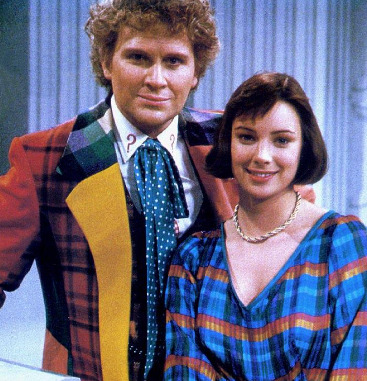
The reason why the story is so weak is because of a lot of the stupid elements. This cross-eyed telepathic slug has subjugated a planet of avian-like people who used to be ruled by a Time Lord scholar named Azmael. And he needs the help of two Earth kids to do a mathematical formula involving moving planets out of their orbit. The Doctor points out a fatal flaw in the proposal, in that the execution of the plan could tear a hole in the universe. Azmael and the twins didn’t even think of it. But that was the slug’s plan all along. Oh, and even though the slug is a hermaphrodite, he’s got the hots for Peri. Get all that? Yeah.
And why didn’t Azmael recognize the Doctor? The Doctor proclaims that it must be because he’s regenerated since they last saw each other, but I don’t buy that as we’ve seen over and over again that Time Lords recognize each other despite regenerations (usually anyway). Maybe Azmael was pretending not to because of his embarrassment at participating in this scheme. After all he did claim to be a Professor Edgeworth and at first even denied that he was Azmael…I don’t know.
It’s unfortunate that this was our introduction to the new Doctor. Especially when the gripping “Caves Of Androzani” with an amazing regeneration at the end could have ended the season on such a high note.
And Another Thing…
“Caves Of Androzani” would have been even better if not for that paper-mache magma beast. Ugh, let’s not speak of it again.
The Sixth Doctor: “You may come to find that I’m not as abrasive as I appear.” Peri: “Well that’s a relief. But now what?” The Sixth Doctor: “Whatever else happens, I am the Doctor - whether you like it or not!”
#doctor who#fifth doctor#sixth doctor#the caves of andozani#the twin dilemma#peter davison#colin baker#TARDIS#Regeneration#review
0 notes
Text
Doctor Who Regeneration Series Revisited: The Fourth Regeneration
youtube
[The Watcher looks at the group from across a street] Nyssa: “That's the man who brought me from Traken.” Fourth Doctor: “Yes.” Nyssa: “He said he was a friend of yours.” Adric: “But he's the man on the bridge.” Fourth Doctor: “Yes.” Adric: “You said to be prepared for the worst”. Fourth Doctor: “Indeed I did, and I am prepared for the worst.” Adric: “Why are you prepared for the worst, Doctor?” Fourth Doctor: “Because he's here.”
Story (from “Logopolis” and “Castrovalva”):
New companion Adric finds the Doctor pacing deep within a room in the TARDIS. The Doctor admits that based on the last few adventures, between leaving Romana in E-Space and seeing the Master come back to challenge him once more, he has become concerned with entropy: the nature state of decay of the universe. Even parts of the TARDIS are showing their age and breaking down. To feel like he’s doing something about it, the Doctor resolves to fix the Chameleon Circuit and restore the TARDIS’ ability to blend in with it’s surroundings.
To do so, the Doctor plans to materialize around a real police box, take accurate dimensions of it, then go to Logopolis, a planet inhabited by the best mathematicians in the universe. He believes they will be able to use ‘block-transfer computations’ based on the dimensions to fix the TARDIS.
Upon materializing around the police box however the Doctor finds that he has actually materialized around the Master’s TARDIS, as the Master had anticipated this move. The Doctor tries to shake the Master out of his TARDIS through some maneuvering, but stops when he comes in contact with a being referred to as The Watcher. The Doctor goes to speak to The Watcher while Adric watches from a distance, and The Watcher convinces the Doctor to go straight to Logopolis. Meanwhile The Watcher brings Nyssa, a friend of the Doctor’s, from Traken to help him as she is a brilliant mathematician herself.
At Logopolis, the Doctor and the Monitor (leader of the Logopolitans) attempt to fix the TARDIS, but the Master interferes with the calculations and sabotages the TARDIS instead. By going through and murdering Logopolitans, the Master accidentally interferes with the grand scale computation they were involved in; the Monitor reveals that the universe long ago passed the point of it’s natural demise, and Logopolis was keeping it stable by bleeding the entropy off into CVEs, which act like vents. Now the universe is threatened, and Logopolis falls into the entropy.
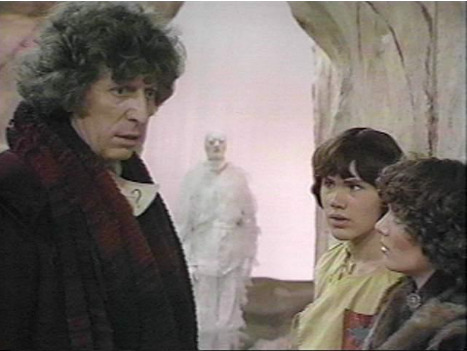
The Doctor and the Master agree to a truce to solve this dilemma and go to the Pharos Project on Earth, which has a massive satellite dish and is in the prime position to finish the Logopolis computation. At the last minute, the Master decides he wants to hold the universe itself at ransom until they acknowledge his supremacy. The Doctor runs out on to the dish to manually complete the computation, but the Master has set the dish to rotate as he’s doing so. As the Doctor finally succeeds, he slips and plummets to the ground.
As the Doctor lies on the ground, Nyssa, Adric, and an Australian flight attendant named Tegan who’s been along for the ride rush to his side and discover The Watcher already there. He walks to the Doctor and merges with him, causing the regeneration. Nyssa realizes that The Watcher was a projection of the Doctor the whole time.
After the regeneration is completed, the three try to get the weakened Doctor to the TARDIS, but are arrested by the Pharos Project security. Tegan stages a jailbreak, so that she and Nyssa can bring the Doctor into the TARDIS. But the Master has used this opportunity to kidnap Adric and tap his brain to create his own block-transfer computations.
The Doctor stumbles around the TARDIS looking for something called the Zero Room. He explains that the regeneration is failing due to the trauma and that the Zero Room has a restorative effect on Time Lords by silencing out all background noise. They find it, and while the Doctor is recuperating Tegan and Nyssa have discovered that the Master has used Adric’s mind to sabotage the TARDIS (again) to send it to Event One: the creation of the universe (again). The TARDIS is unable to handle the immense heat and is seconds from being destroyed, but the Doctor is able to regain his senses long enough to save them.
This was truly too taxing for the Doctor though, and Nyssa takes him back to the Zero Room, only to find it was jettisoned to make good their escape. Meanwhile, Tegan has found in the databanks there is a planet called Castrovalva that has the same properties of the Zero Room. She successfully sends the TARDIS there; unaware that Castrovalva is home to yet another trap set by the Master.
Production:
It had been seven years under Tom Baker’s reign as the Doctor, and 1981 was to see some big changes in the program. John-Nathan Turner had become producer and would remain so until the end of the series. He wanted to bring Doctor Who back to its roots and introduce more cerebral science fiction. He instituted the changes, including a remixed theme song and question marks adorning the Doctor’s costumes, in the hopes of bringing new life and viewers to the show.
One problem was Tom Baker. As the years had rolled on he had become quite difficult to work with, frequently arguing with directors, ad-libbing lines to the writers’ frustration, and generally being belligerent (sometimes even remaining in Time Lord character and inserting weird alien customs into scenes that didn’t call for it). Luckily, the production team had an out for this. Right before the start of the last few seasons, Tom would approach the team and say “I think I’ve been doing this too long” and the team would always say, “Oh no no Tom don’t go, we need you!” But at the beginning of this season, Tom made his usual spiel about getting long in the tooth, and the team agreed it was time for a change.
The change was to be with the casting of 29 year old Peter Davison, the youngest actor to play the role so far. He had already been known as a great actor to deal with and had found success starring as a veterinarian in the series “All Creatures Great And Small.” It came as some surprise to him to be cast, as he had been watching the series since he was a child (Patrick Troughton being his favourite). He was hesitant, but decided to take the role lest he regret never trying.
It was decided though that Tom Baker’s last story “Logopolis” was to be a story of huge proportions. Not only would he face off against the Master again, who had recently stolen the body of Nyssa’s father to prolong his life (as the Master has used up all his regenerations…more on this soon), but he would wind up saving the universe, albeit only mostly as the entropy unleashed by the Master did already engulf and destroy some systems.
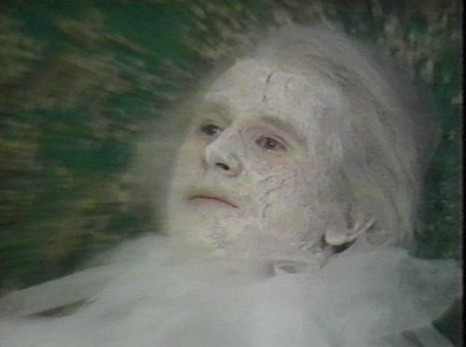
Taking a cue from the last regeneration, the team introduced The Watcher, a wraith-like figure completely embalmed in white who the viewers would regard with suspicion. He is never heard speak, and there was no way to know who he really was until the end: a projection of the Doctor’s regeneration. Story editor and script-writer Christopher Bidmead thought that there were two notions he really wanted to exploit in “Logopolis”: the idea of a TARDIS within a TARDIS, and the dimension recursion it might cause, and the idea that although a regeneration might seem to be a straight-forward process to an observer, to a Time Lord the process might extend through time like a ripple.
Bidmead continued this exploration in the story “Castrovalva” which involves a planet’s society that only exists because the Master has used computations to create recreations of living people (a holodeck?). This notion of the Master being able to deftly anticipate the Doctor’s every move would be carried on through the Fifth Doctor’s entire run.
As for the regeneration itself, it was again a straight video mix, but handled far better. It starts with an overlay of The Watcher walking into the Doctor with a light up effect, and then the Doctor dissolves into The Watcher. The next dissolve is that of the Fifth Doctor covered in the white embalming of The Watcher and then a dissolve into the Fifth Doctor completely normal. Simple, but far more effective than the last regeneration.
Analysis:
During the Fourth Doctor story “The Deadly Assassin”; we finally learn that Time Lords have a maximum of twelve regenerations giving them thirteen lives. We also learn in that story that the Master, having used up all his regenerations, tried to force another one but burnt himself to a crisp. This served not only to have someone new play the Master (although layered in makeup) but to establish that regeneration can be a dangerous process. In “The Keeper Of Traken” the charred Master steals the body of Tremas (catch that? Yeah, you did) to prolong his life. This also introduces the notion of a Time Lord being able to steal bodies…but more on that with the seventh regeneration.
Later, in the story “The Brain Of Morbius”, the Fourth Doctor and the renegade Time Lord Morbius have a psychic battle with a view screen that shows the incarnations of whomever is losing…and the Doctor has faces from before Hartnell, indicating past regenerations. At the time the implication was just that the Doctor had led more lives before Hartnell, but by the time of this regeneration it became a point of contention. Several theories floated around like they’re actually faces of Morbius, and he just doesn’t realize he’s losing at that point, or that the Doctor is pretending to have previous regenerations to seem more threatening (like a blowfish). We now know as of 2022 that the Doctor did indeed have more lives before Hartnell, and was unaware of them due to Time Lord meddling (more on this in a future article).
“Logopolis” can be a hard story to follow at first. It’s a little hindered by the effects of the time and as such the world of Logopolis looks a little silly. Plus I wonder why Logopolis and Earth would have identical satellite dishes. That strains credibility a bit. Also silly is the Doctor’s plan to flush the Master out of the TARDIS by submerging it in the Thames and opening the doors. He never actually gets around to doing it but…really?
The Watcher idea is a pretty good one. I already mentioned in the last article that it seems that in times of great flux, a Time Lord can have a projection of themselves post (or mid I guess) regeneration come help them out to smooth out the flux. And given the stakes of this story, that seems very reasonable.
Now, on to the Zero Room. This seems to be the reason why the Doctor regenerates in or near the TARDIS so frequently. In the case of it failing, which seems to be defined as the synapses not fully reformed, the Zero Room exists to block out all the background noise that Time Lords pick up (see “Planet Of The Ood” with the Tenth Doctor as an example). So one wonders if that’s the only reason or if the TARDIS also aids the process itself. To this day that’s still mostly unanswered. The Doctor also mentions that the best Zero Room is under the Junior Senate on Gallifrey in the Capitol. So one can also infer that they are fairly common on Gallifrey, or at least, not uncommon.
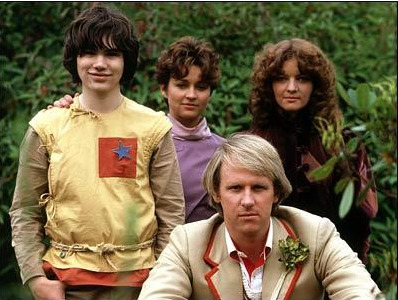
With “Castrovalva”, I had a hard time with the notion that the Master could use Adric’s brain to not only sabotage the TARDIS but also install a fake console, with a fake database, AND create a fake city. I get what they were going for with block-transfer computations, seeing as how Doctor Who has before and since used the power of abstract mathematics as a tangible commodity. In fact the Tenth Doctor story “School Reunion” revolves around Skasis Paradigm which essentially grants one control of the universe. I guess the Logopolitans have cracked the equation; something the Time Lords weren’t able to do (or maybe never tried). But why Adric? Okay, he’s smart (too smart – most fans hate(d) him). Nyssa seems to make a more logical choice as she’s both a mathematical genius and seemed to have a greater understanding of the computations. I guess torturing women on television is too risqué, so torturing teenage boys makes more sense then?
That being said, I really like the first half of the story. Seeing the Fifth Doctor “channel” his previous selves was surprisingly well done and without Adric cluttering up the screen we see genuine tension with Nyssa and Tegan trying to save the TARDIS from Event One.
Speaking of which…didn’t they already do that? The First Doctor story “Edge Of Destruction” has a switch breakdown in the TARDIS causing the ship to shoot towards Event One. The TARDIS itself actually tried to warn everyone on board of what was happening (a clock face melting, the scanner malfunction, etc.) Couldn’t they have used a supernova or something instead?
Anthony Ainley is properly introduced as the Master in “Logopolis”, and he’s quite sinister. The biggest objection people have had to him is that he emulated Roger Delgado a little too much and didn’t bring too anything new to the character. This is open to debate of course and since he was the first incarnation of the Master I saw, I like him. When on screen he’s amazingly diabolical and you can tell just by looking at him that he’s dangerous. He’s also an excellent juxtaposition against the Fifth Doctor. I think the Fourth Doctor’s Master, the one all charred up and mutilated, better served against Tom Baker’s irascible Doctor.
The Doctor’s costume is kind of a weird choice. I like it, don’t get me wrong, but a cricketer’s uniform with a stalk of celery pinned to it is pretty odd. We get the explanation very early on that the Fifth Doctor is an aficionado of the game, but we don’t find out about the celery until his last story.
And Another Thing…
The mysterious fabric regeneration strikes again! The Doctor’s boots regenerated into shoes.
Adric: “Are you sure you're all right?” Fifth Doctor: “There's strong dimensional forces this deep in the TARDIS, tend to make one a bit giddy.” Adric: “And the regeneration?” Fifth Doctor: “I don't know. I can feel it isn't going to be as smooth as on other occasions. Sooner we get to this Zero Room place the better, eh?”
#doctor who#fourth doctor#fifth doctor#logopolis#castrovalva#tom baker#peter davison#TARDIS#Regeneration#review
0 notes
Text
Doctor Who: Regeneration Series Revisited - The Third Regeneration
youtube
K’anpo: “The Doctor is alive.” Sarah: “You're wrong - he's dead.” K’anpo: “All the cells of his body have been devastated by the Metebelis crystals, but you forget - he is a Time Lord. I will give the process a little push and the cells will regenerate. He will become a new man.” Brigadier: “Literally?” K’anpo: “Of course, he will look quite different.” Brigadier: “Not again!” K’anpo: “And it will shake up the brain cells a little. You may find his behaviour somewhat...erratic?”
Story (from “Planet Of The Spiders” and “Robot”):
While conducting experiments on ESP, the Doctor and the Brigadier receive a package from the Doctor’s old companion Jo Grant containing the blue Metebelis crystal. Even though it was given as a parting gift from their last adventure together on Metebelis 3, it seems to be causing trouble for Jo and her new husband, and she wasn’t sure what to do with it. The Doctor finds that unexpectedly, the crystal is able to amplify mental energy.
Meanwhile, Mike Yates of UNIT is on leave at a retreat run as a monastery by a Tibetan monk named K’anpo Rinpoche and his aide Cho-Je. Some of those in attendance however have found a way to channel their mental energy into opening a rift in space-time. They hope to acquire power, but instead a giant spider is brought through the rift. It latches onto the back of the leader of the men, Lupton, and enters his mind. The spider has been sent to find the blue crystal, as it will grant the spider leader-deity (The Great One) with tremendous power. But the spider and Lupton agree to use the crystal themselves to acquire the power.
The spider grants Lupton powers of teleportation, and he uses this to steal the crystal. Unfortunately a handyman at the retreat finds the crystal and steals it from him. Lupton and the spider return to Metebelis 3 anyway, hoping to bluff the Queen Spider. The Doctor’s companion Sarah Jane, after investigating the strange circumstances there at the behest of Yates, is swept to Metebelis 3, and the Doctor must go to recover her.
While there he learns there is a human population being used as a slave caste on the planet, they’re from Earth...as are the spiders. The ship was a colony ship that crashed on Metebelis 3 some time after the Doctor had last been there. A collection of the perfect blue crystals had amplified the mental abilities of the stowaway spiders onboard, and mutated them into giant super beings.
While rescuing Sarah Jane, the Doctor is lured into the crystal chamber, where The Great One confronts him. Her mental power is so great she can control the Doctor’s mind and his fears, and she commands him to recover the blue crystal for her. He flees the chamber and, with Sarah Jane, goes back to Earth.
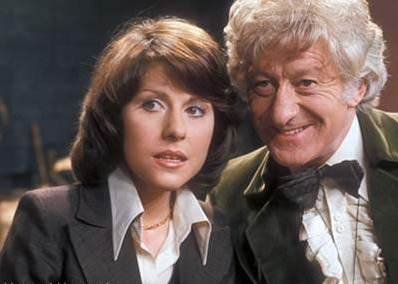
The Doctor goes to confer with K’anpo about the location of the crystal, and discovers that K’anpo is a Time Lord: his old mentor from when he was a child. His aide, Cho-Je, doesn’t actually exist and is a projection of K’anpo’s future (Confused? More on this later). An invading wave of spiders come through the rift and latch onto the residents of the retreat, looking for the crystal. In the ensuing chaos, K’anpo is killed, but regenerates into Cho-Je. The Doctor finds the crystal and returns to The Great One. It is then that The Great One reveals her plan: she is going to use the power of all the perfect crystals, now that the last one is recovered, to amplify her mental powers to conquer other worlds through telepathy. The Doctor asserts that this is impossible and the resonating feedback will only kill her, but she disregards what he says. As expected, after trying to amplify her power, she dies screaming. The resulting release of mental energy kills all the other spiders, and devastates the Doctor’s body. He stumbles into the TARDIS.
Three weeks later, Sarah Jane and the Brigadier are mourning the Doctor’s loss, believing he must have been killed. It is then that the TARDIS materializes and the Doctor, weakened and dying, stumbles out. He tries to console Sarah Jane, but seemingly dies. K’anpo appears in the room, encouraging Sarah Jane, and kick-starting the Doctor’s regeneration with some of his energy.
The UNIT medical officer, Lt. Harry Sullivan, comes in to care for the Doctor, who is delirious, confused, and suffering from some amnesia. After several days of unconsciousness the Doctor attempts to escape UNIT in the TARDIS, but Sullivan stops him, trying to coax him to rest. The Doctor attempts to prove his competency, but in the end ties Sullivan up and throws him in a closet. The Brigadier and Sarah arrive just in time for the TARDIS to start taking off, but Sarah begs the Doctor to come help them. Someone, or something, was able to walk through top-level defenses and steal top-secret parts and plans for a disintegrator gun.
Production:
By the end of the eleventh season, 1974, talents in front and behind the screen were feeling worn out. Jon Pertwee had owned the role of the Doctor for five years, and in that time had gone from Earthbound exile to redemption with the Time Lords and freedom to roam the stars once again. But Pertwee himself was tiring of the role. The first actor to play the Doctor’s archenemy the Master, Roger Delgado, was killed tragically in a car accident. Delgado and Pertwee were close friends, and the news was a shock to the actor. Katy Manning, who played Pertwee’s longest companion Jo Grant, also left the series for other projects, and Pertwee felt his time had come to an end. Although the shooting schedule wasn’t as hectic as his predecessor’s, it was still physically and mentally demanding. Pertwee was known to have no mind for techno-babble dialogue, and would often resort to “reversing the polarity of the neutron flow” anytime he wanted to say something smart. And no, it doesn’t make any sense.
Producer Barry Letts and script editor Terrence Dicks had been on board for just as long in their current capacity, and even longer in other capacities. And they too wanted to take a break and then move on to other projects. There was some worry that the series was getting a little stale, as even though the Doctor not only had use of his TARDIS again, he had far more control than any of his past incarnations, but was still returning to Earth as if stationed there.
The oncoming producer Philip Hinchcliffe wanted to go back to Doctor Who’s origins, and see him come away from being so tied down. The production team took a few notes from the very popular Hammer Horror series to introduce darker aspects, with more fantastic monsters, and more exotic locations. New effects and production freedoms promised to make for an interesting series.
The regeneration technically was a straight video mix, and was foreshadowed heavily by the regeneration of K’anpo – as such, viewers easily identified what had happened. At this point, dialogue with K’anpo only indicated that Time Lords could regenerate. There was no discussion as to a limit, or which body the Doctor currently inhabited. Indeed, in a soon-to-be seen episode, “The Brain Of Morbius”, there is an implication that the Doctor had previous regenerations before Hartnell, but more on that later.
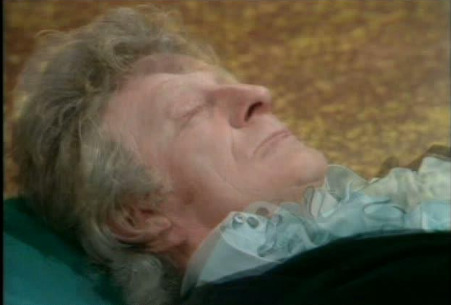
In the new series, viewers were introduced to a younger Doctor, a quirky and unusual Bohemian Doctor, portrayed by Tom Baker. Baker was an odd actor, with sadly few roles under his belt. The appeal to him though was that he was a fresh face not only for the character, but also for the series. The costume selected for him was instantly recognizable but markedly different than past incarnations. His oddball behaviour was easily explained by the regeneration.
To reassure long time audience members, the first episode of season 12, “Robot”, was more of a traditional Pertwee story. Something askew happens on Earth, UNIT is called to investigate, the Doctor advises using scientific and unorthodox knowledge, UNIT soldiers open fire on something while the Brigadier barks orders, and the Doctor’s companion get kidnapped. But from that point on, the series adventures out into the unknown, and in many ways, this season was a continuous story. And with both a Dalek story and a Cybermen story, it harkened back to the early days of Doctor Who. Tom Baker would stay on for seven years, and not only would fantastic new elements be woven into the franchise, but the Doctor would acquire a new arch-enemy: Mary Whitehouse of the National Viewers and Listeners Association, who felt the show was too scary for children, and unsuitable for family audiences. She would dog the show for years to come.
Analysis:
“Planet Of The Spiders” was a weak story that promised to be so much more. There were some really good elements, and some of the plot developments were interesting, but they tried to cram too much into it. I can understand wanting to make a story epic but when you bog it down with excessive elements, you are left with a mess. Examples: the human “two-legs” rebellion, the Spider Queen being challenged for her place, the episode-long chase scene (gah!), Tommy the Handyman and his mental awakening, Professor Clegg and his ESP, The Great One’s crystal chamber….man. That’s only part of what goes on in this six-parter, and because the writers tried to focus on all of it, we get no focus at all. Barely present is the Brigadier, a staple of the series for the last five years. This story is supposed to be the end of an era, and one of our principle characters is missing for more than half the story.
Every episode, I said to myself “I want to see K’anpo…I want to see more Cho-Je.” I already knew about this character(s) from reading up on the story, but I wanted to see him/them fleshed out. This is a character who has been alluded to in past episodes – the Doctor’s mentor! You finally see K’anpo in episode five. So…why was episode two just one long chase scene??
You’re probably wondering about this Cho-Je / K’anpo thing, and with hindsight it’s easier to explain…but I have to admit that I don’t know what the writers were thinking at the time. The explanation given was that Cho-Je was a projection of K’anpo, and technically didn’t exist. This projection had physical form, and a different personality, but the same core traits. Then when K’anpo is zapped, Cho-Je vanishes, and K’anpo regenerates – looking, and acting, like his Cho-Je projection. Yeesh. The regeneration here is a straight video mix, like the Doctor’s later in the story. So not really that flashy.
Now, I’ll talk about this more in the next article, but with hindsight we now know that in times of great flux in the timeline that results in a regeneration, Time Lords will occasionally meet up with that regeneration before it occurs – the regenerated form has a temporary existence through a ripple in time. In the instances where we see this happen, the Time Lord in question will recognize immediately what is happening and this “temporal projection” will often aid them to smooth out the flux, and ensure everything proceeds as it should. It’s reasonable to say that this doesn’t happen often, given the Time Lords’ rule of non-interference, but even the Doctor acknowledges K’anpo’s great power. He is even seen traveling through space-time without a TARDIS. Does he have one of those Time Rings, and he’s just hiding it under his cloak? Or maybe he successfully absorbed some of the time vortex (more on that with the Ninth Doctor…)?
So we’ve got all that buildup for a regeneration, and when we see our beloved Jon Pertwee regenerate we get….a video mix. No white out. No facial contortions. Just a straight mix. These days, kids can do better in camera. I can’t help but feel cheated. A part of me wants to justify it and say that his energy was absorbed by the Metebelis crystal leading to a subdued regeneration, but I’m not going to say that. I’m going to say that we have a poorly constructed episode, where the director saw the tradition of regeneration before him and said “Ah screw it. Bring in the next guy.”
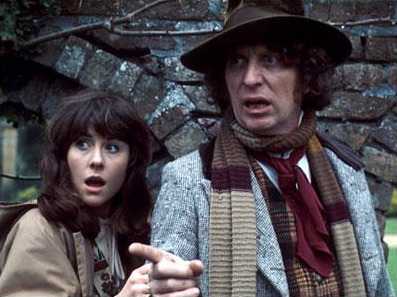
The next story, “Robot”, is a lot better. First off, a tighter and more interesting story is told in these four episodes. Sure, it owes a lot to King Kong and Frankenstein, but what a great introduction. The Brigadier gets a proper send-off this time (but we’ll see him again from time to time), and as I stated earlier, the story salutes the Third Doctor story formats, before moving off into a completely new direction. The first Doctor Who story in colour I saw was “The Sontaran Experiment”, which is only a couple stories away – midway through season 12. I used to set a timed recording on my VCR to catch it (as it was on at 5 am or something), and when I first played it back, I thought it had been preempted by something else. But I heard the familiar theme music, and WOW! What a change from the black and white days! The production was crisper, and that time vortex behind the credits was really something to look at. Season 12 was sharp and refreshing, and firmly established Tom Baker as a reckoning force. To this day, he is still probably the most popular Doctor and it’s easy to see why. He’s charming, toothy, smart, kooky, and instantly recognizable. There’s still a lot of cheese though, but mostly once you get into the 80’s.
We see a tradition really brought to fruition with this regeneration, and that is his post-regenerative trauma. This is more than simple fatigue, and is closer to the oddness we saw Patrick Troughton exhibit – the brain seems a little scrambled. With each regeneration, a new spin is put on it, but it invariably still exists in some form. Also worth noting is the proximity to the TARDIS, a commonality we also see, which we’ll look into far more with the next entry.
I digress. Go to YouTube and look for a “remastered” version of the regeneration. Several fans have done it using a white out effect and blur, and it looks far better.
And Another Thing...
Don’t even get me started on the Whomobile.
The Fourth Doctor: “A new body is like a new house... takes a little bit of time to settle in. As for the physiognomy? Well... nothing's perfect. Have to take the rough with the smooth. Mind you... I think the nose is a definite improvement. As for the ears? Well I'm not too sure. Tell me quite frankly... what do you say to the ears?”
#doctor who#Third Doctor#fourth doctor#planet of the spiders#robot#jon pertwee#tom baker#TARDIS#unit#Regeneration#review
0 notes
Text
Spider-Man TAS (Without Spider-Man): Mutant’s Revenge
So is Peter Parker right when he says the world would be better off without Spider-Man? Let’s find out.
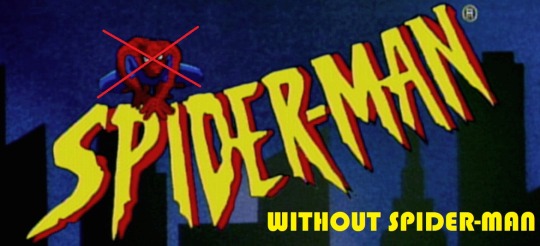
Wolverine is hot on the trail of Jubilee when he runs into Hobgoblin outside the Langdon research labs. Hobgoblin has every intention of stealing the army tech destined for Kingpin from Langdon, and using it for his own means. Like robbing banks or something. He’s so caught up in his own monologuing that Wolverine gets the drop on him, and beats the tar out of his ugly mug, demanding to know where Jubilee is.
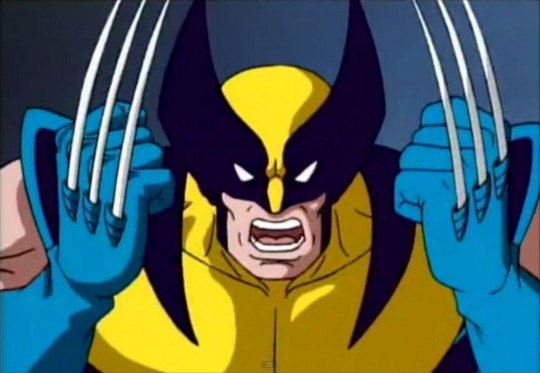
Of course, Hobgoblin thinks that Jubilee is some kind of kid’s birthday party store, so he tells Wolverine to check the mall. This only infuriates Wolverine further, who thinks Hobgoblin is being coy (he’s not). However a sudden and barely discernable cry for help stops Wolverine from fricassee-ing Hobbie.
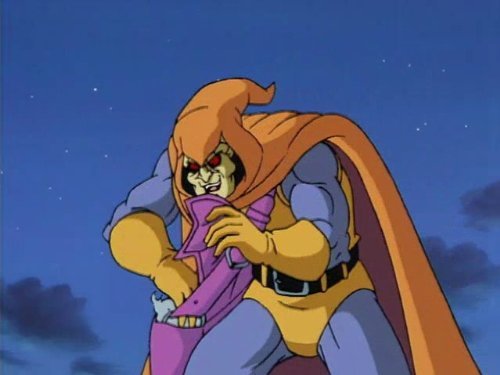
Meanwhile, Langdon and his assistant Dr. Plot Device are monologuing to Jubilee about how mutants are just so ew ick. Jubilee keeps crying out for help because that’s what she does best, and sure enough Wolverine stampedes through about a hundred laser shooting guards and several blast doors. He tosses Langdon into the pot of boiling evil, and frees Jubilee while Dr. Plot Device runs away crying.

Langdon turns into a giant multi-eyed green monster (obviously), just as the rest of the X-Men show up. Beast is aghast that his old friend and colleague used his old research to try to kill Jubilee, and is deeply embarrassed it turned Langdon into a kaiju. The X-Men use a bevy of one-liners tailored to their abilities (”You’ve been dealt the wrong hand mon ami” says Gambit as he hucks charged playing cards... look you just had to be there), and Beast figures out that voodoo radio waves will reverse the mutation kind of.
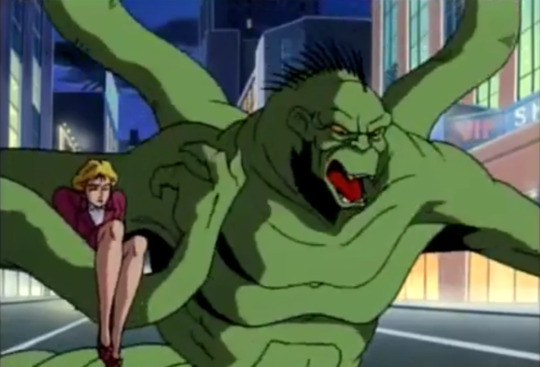
Langdon shrinks down to a good size (good enough for Dr. Plot Device, who is also a mutant?), but is now half Swamp Thing. The X-Men consider that a good Thursday and piss off.
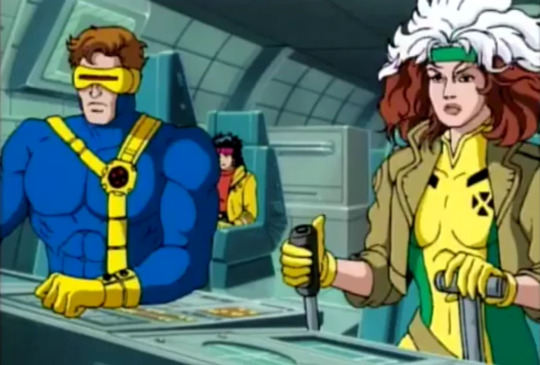
1 note
·
View note
Text
Spider-Man TAS (Without Spider-Man) - The Mutant Agenda
So is Peter Parker right when he says the world would be better off without Spider-Man? Let’s find out.
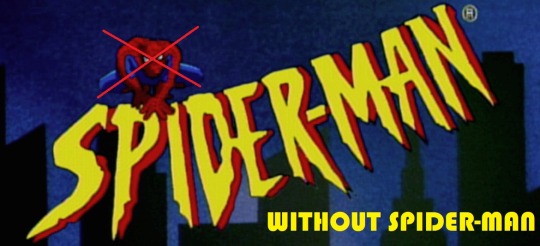
The X-Men are relaxing after yet another adventure stopping Mr. Sinister (or something) during a classic upper state New York thunderstorm. Jubilee, that plucky teen, gets it into her head that she wants to go out for some fresh air. Wolverine tells her that she’s playing into her stereotype again, but she gets impetuous and storms out in a mood.
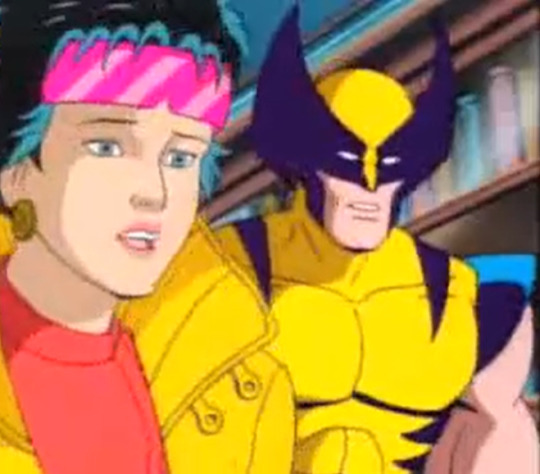
No sooner is she outside the compound when she is ambushed by a bunch of guys with guns who use electric cables and a sonic shockwave to knock her out. When she doesn’t come back to the mansion after a few hours, the rest of the team have to draw straws to see who has to rescue her this time. It’s Wolverine (again) and he grumbles. Meanwhile, a classy doctor meets up with Hobgoblin to pass over a briefcase of money. The doctor, Herbert Langdon, actually booby-trapped the briefcase and it explodes. Hobgoblin is not amused.
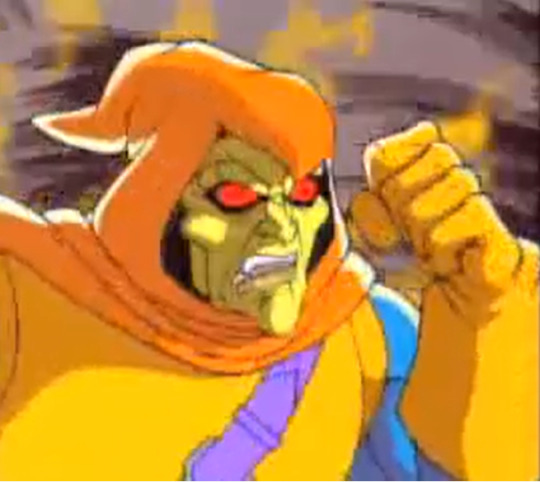
Kingpin is also involved with Dr. Langdon as well, trying to get the doctor to manufacture a mutant army. Kingpin thinks THIS is the plan that will impress the other crime bosses, especially after his Focaccia Four broke up. Smythe doesn’t trust Langdon, but he really doesn’t trust anyone.

Dr. Langdon is giving a speech on mutants, and coming off like a charmer before the packed lecture. But Hobgoblin comes in and decides to terrorize everyone. He starts menacing Langdon, and Langdon finally agrees to pay Hobgoblin a million bajillion dollars, and definitely no tricks this time. Hobgoblin agrees like an idiot.
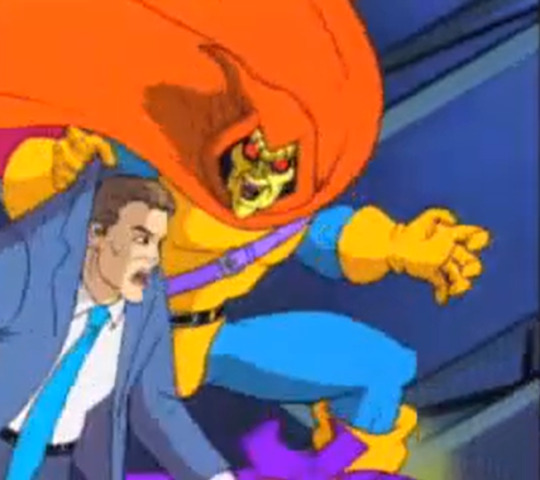
Jubilee wakes up in Langdon’s lab, and wonders why she’s been kidnapped this time. Langdon explains his whole evil plan: you see, he’s going to cure mutants by killing them all! Makes perfect sense! Jubilee tries to use her firework fingers, but they predictably don’t work. Guess you gotta wait for that rescue, kid.

1 note
·
View note
Text
Spider-Man TAS (Without Spider-Man) - Hydro-Man
So is Peter Parker right when he says the world would be better off without Spider-Man? Let’s find out.
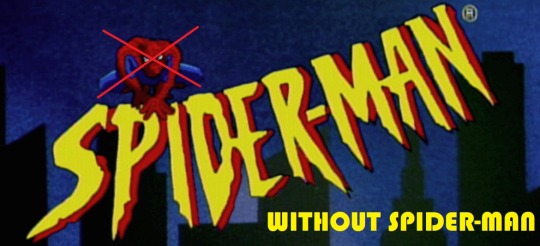
Peter and Mary Jane are out for another coffee date, and things are going swell. If Peter is lucky, he might even get to first and a half base! Peter passes a bunch of photos to her that he took, for purely professional reasons (really!). She thanks him, and the two share a smile but she pulls away. Suddenly she can’t commit to a relationship. A phone call pulls her away from their table, and a familiar voice tells her that it’s time for some stalking!

MJ blows Peter off and runs home. She doesn’t quite make it before her highschool sweethear Maury finds her. Seems that he was an enormous loser when they dated, not because he was broke but because he was a possessive asshole. He insists he’s changed, and then tries to kidnap her. Seems that while in the Navy, ocean gas changed him into being....water. So now he goes by Hydro-Man, but good luck hearing anyone call him that. His attempt to kidnap her fails when he has a temper tantrum and accidentally washes her four blocks away.

MJ goes to hide at her friend Liz’s house, but when Peter goes to find her, Maury pulls some stalker crap and gets there first. He then successfully kidnaps her by almost drowning her and “romantically” throwing her into a pile of stolen jewels.
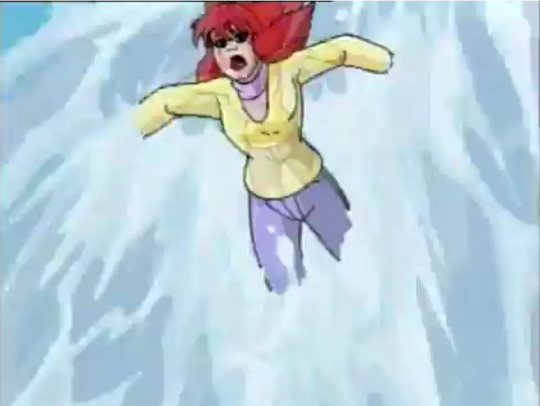
MJ doesn’t find this romantic and Maury has another temper tantrum, throwing the priceless heirlooms around. While he starts whining about how nobody loves him, MJ slips away and runs as far inland as she can. Maury follows her and gets some serious abuse by her. She hucks a cargo hook through his torso, drops a full ton of newsprint on him, and even says he’s a selfish lover. By the time Maury successfully catches up to her, the two are on a roof a few miles from the river. Exhausted, Maury whines like a pussy, then lays down and evaporates. MJ feels bad, but gets over it pretty quickly.
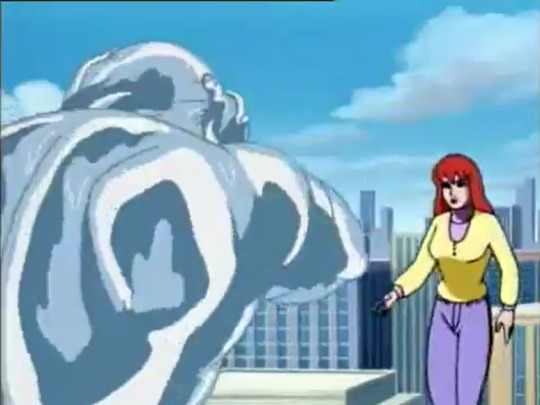
0 notes
Text
Spider-Man TAS (Without Spider-Man) - Battle Of The Insidious Six
So is Peter Parker right when he says the world would be better off without Spider-Man? Let’s find out.
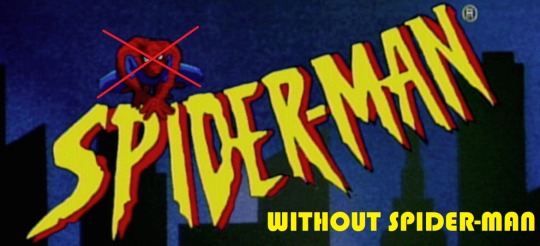
Kingpin calls up Silvermane to gloat about how awesome his crimewave is, thanks to the Fabulous Four. Silvermane thinks that name is way too flamboyant, and doesn’t think that making New York a dystopic nightmare is going to improve profits. The consensus is to still ask for Kingpin’s two weeks notice.
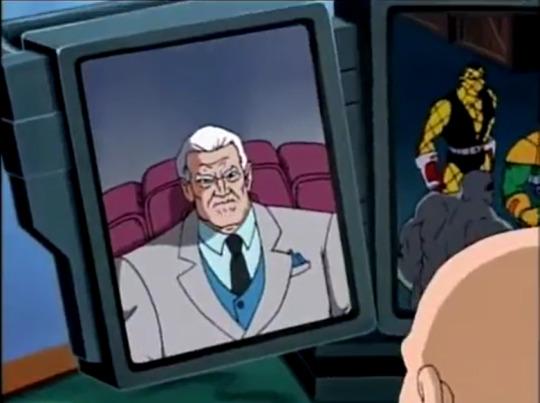
Kingpin is furious and sends the Ferocious Four to go kidnap Silvermane. Maybe terrorizing an old man will bring everyone into line. The plan goes terribly though. Shocker and Rhino know only brute force and get into fights with all the henchmen, Mysterio gets distracted by some of Silvermane’s trophies and decides to make off with them, and Doc Ock just can’t see how this is going to benefit him and leaves. The Feline Four have now officially disbanded. Rhino and Shocker go back to Kingpin and apologize for the failure. Kingpin thinks on what more he can do to hold his power.
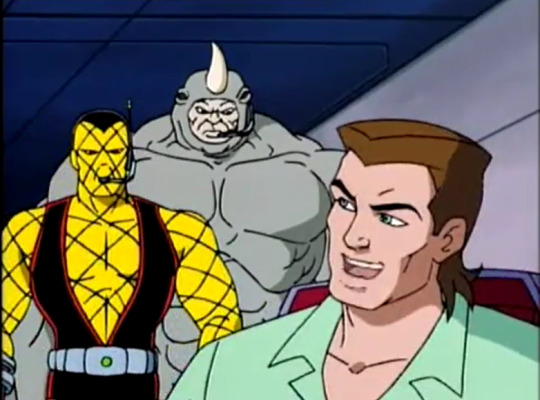
Meanwhile, Felicia Hardy has been hounding Peter for dates under the guise of studying or going to science lectures. Peter is through with this nonsense though, and tells her that things are getting serious between him and Mary Jane. Felicia immediately backpedals and tells him she’s also not interested, now that tall bad boy Morbius is around. Morbius gives Peter a wink and a kissy face.
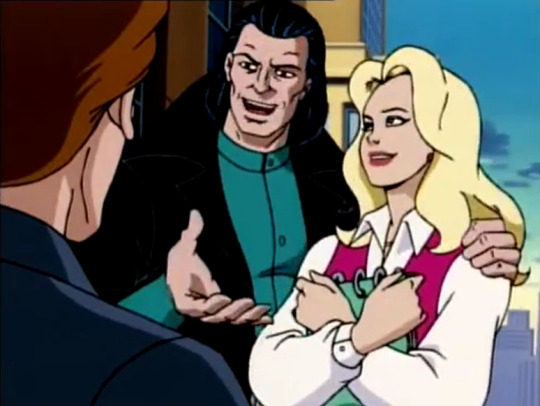
#spider-man#animated#fox#marvel#spider-man without spider-man#kingpin#rhino#shocker#mysterio#doctor octopus#sinister six
2 notes
·
View notes
Text
Spider-Man TAS (Without Spider-Man) - The Insidious Six
So is Peter Parker right when he says the world would be better off without Spider-Man? Let’s find out.

Due to Black Rhino’s destruction of the city and Hobgoblin making a fool out of Fisk, the Crime Lords begin to question whether or not the Kingpin is truly as in command as he believes he is. Silvermane takes the questioning up a notch, and tells Kingpin that they’re all expecting his resignation. Because criminal overlords work best in bureaucracy.
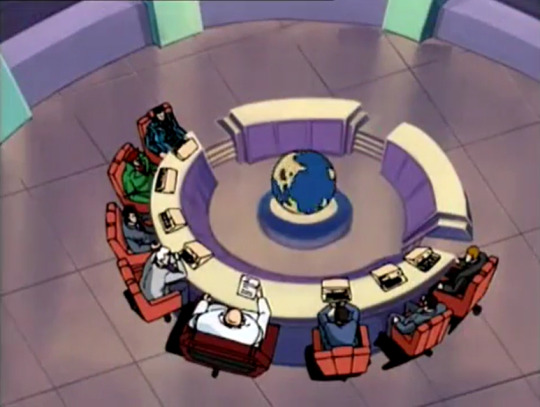
To prove them wrong, Kingpin decides to form a super group of criminals to terrorize the city of New York and embolden petty criminals into pulling in more cash. He recruits Rhino (for some reason), Shocker, Mysterio, and Doctor Octopus. Doctor Octopus immediately hates this idea, but wants to take another stab at a super-lab, which Kingpin can bankroll. Kingpin loves dramatic names, so he calls this group the Fantastic Four. Smythe reminds him that name is already in use, so they settle on the Fearsome Four.

The group begin their crime rampage, and Kingpin pats himself on the back. What could possibly go wrong with this plan? Meanwhile, Dr. Curt Connors is expecting a big grant to fund the neogenics experiments and holds a contest for his top students to become his lab assistance. Peter Parker, Deborah Whitman, and Michael Morbius all jump at the chance, but Morbius thinks he’ll win because he’s already got an awesome jacket and chicks dig him.
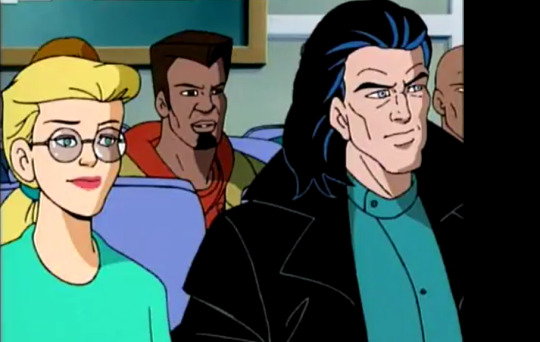
Oh and also Kwame from Captain Planet is in the class. But don’t expect a cross-over event.
#spider-man#animated#marvel#fox#rhino#shocker#doctor octopus#mysterio#kingpin#spider-man without spider-man
1 note
·
View note
Text
Spider-Man TAS (Without Spider-Man) - Day Of The Chameleon
So is Peter Parker right when he says the world would be better off without Spider-Man? Let’s find out.

S.H.I.E.L.D. Agent 1 is in hot pursuit of international assassin Chameleon, who has landed in New York. Nick Fury believes that he is there to assassinate two diplomats, so he must be stopped at all costs. Chameleon assumes the form of some J3 worker and hijacks a helicopter. S.H.I.E.L.D. pursues and chases him through the city. Chameleon crashes into the side of a building, and is killed when the helicopter explodes. Tragically a window washing crew and a half dozen people below are also killed.
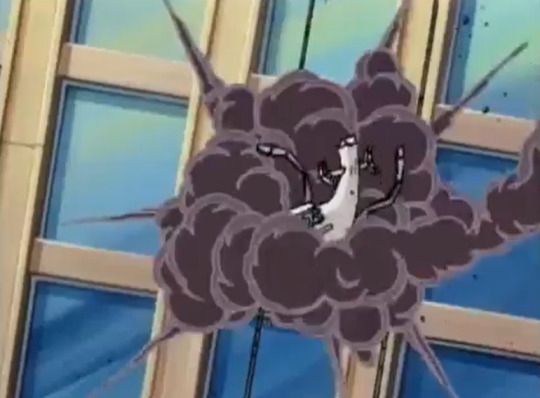
Meanwhile, Peter Parker eagerly vies for the photography job of the diplomats at J. Jonah Jameson’s party. Jameson agrees after some badgering, mostly because he’s distracted by the catering costs.

The party is great, Peter gets a few choice photos, and the diplomats sign the treaty the next day at the UN. Nick Fury breathes a sigh of relief and congratulates Agent 1. Looks like Chameleon will no longer be a thorn in their side.
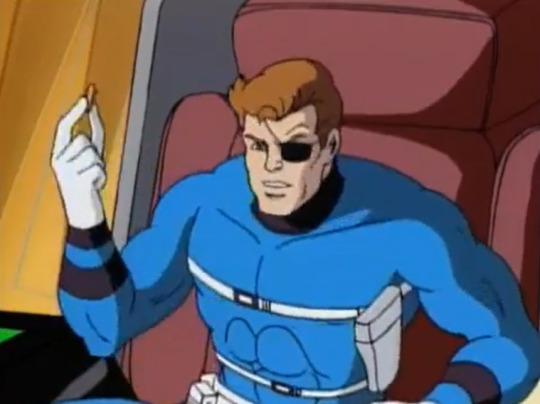
1 note
·
View note